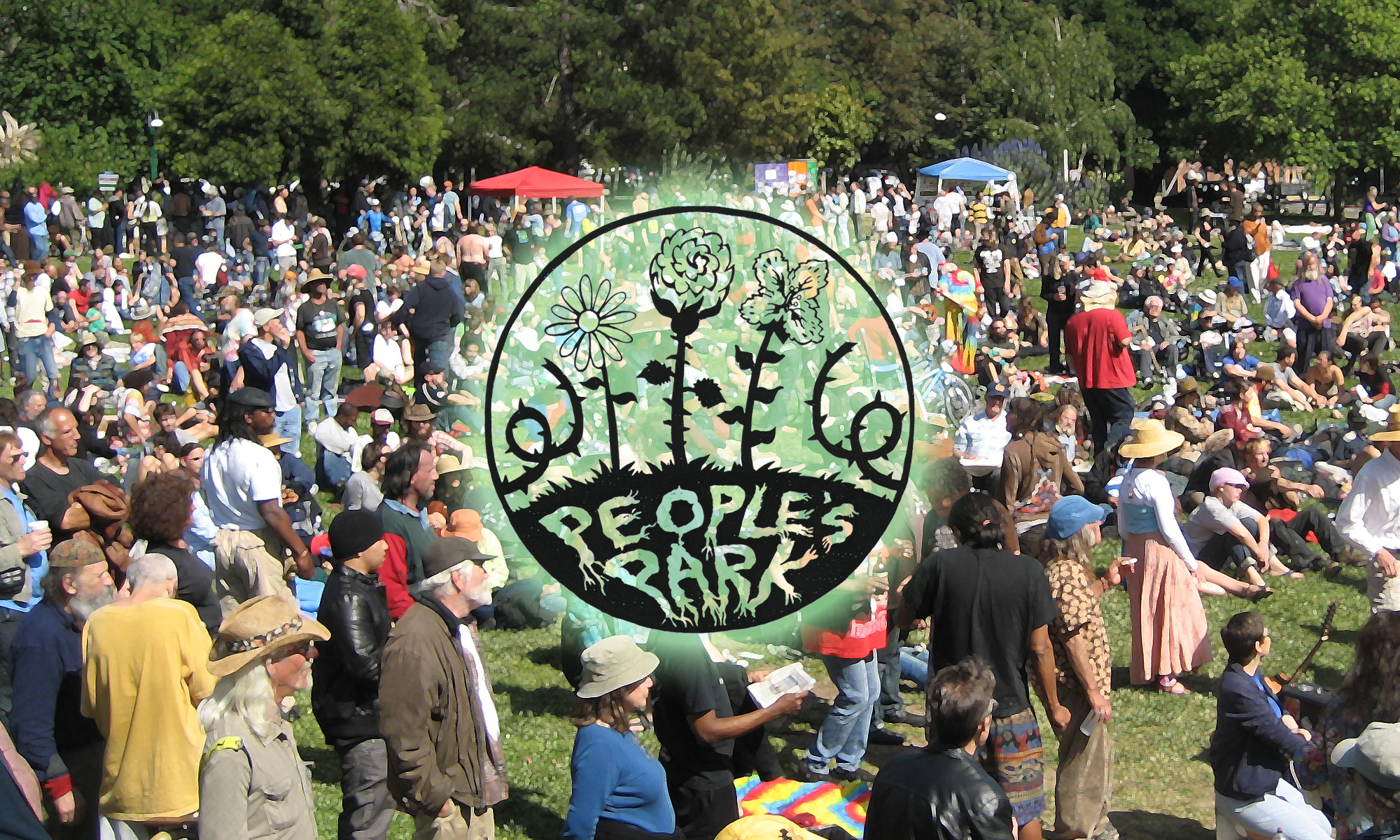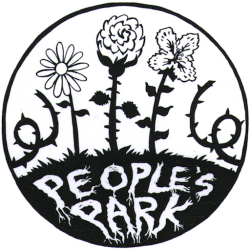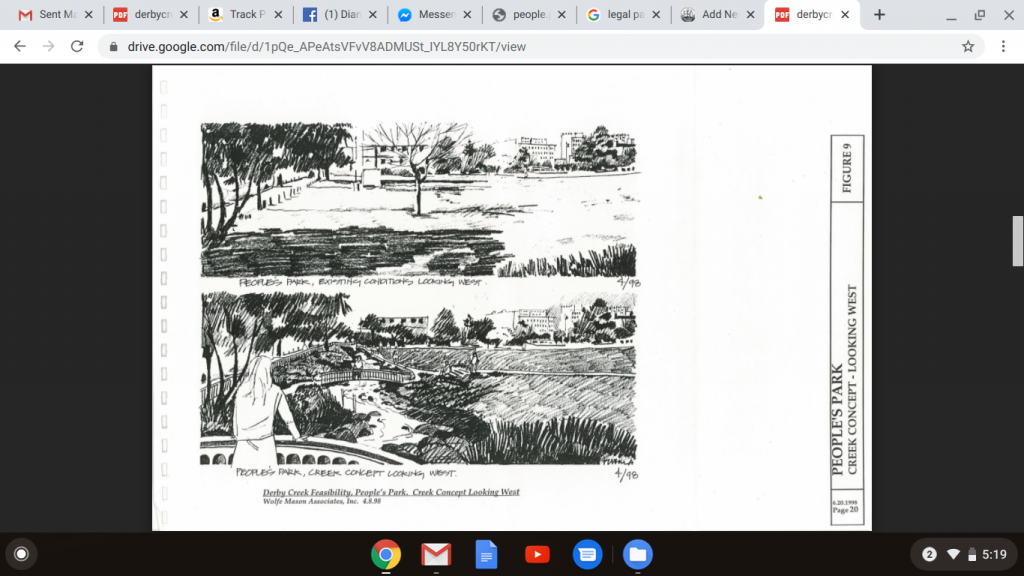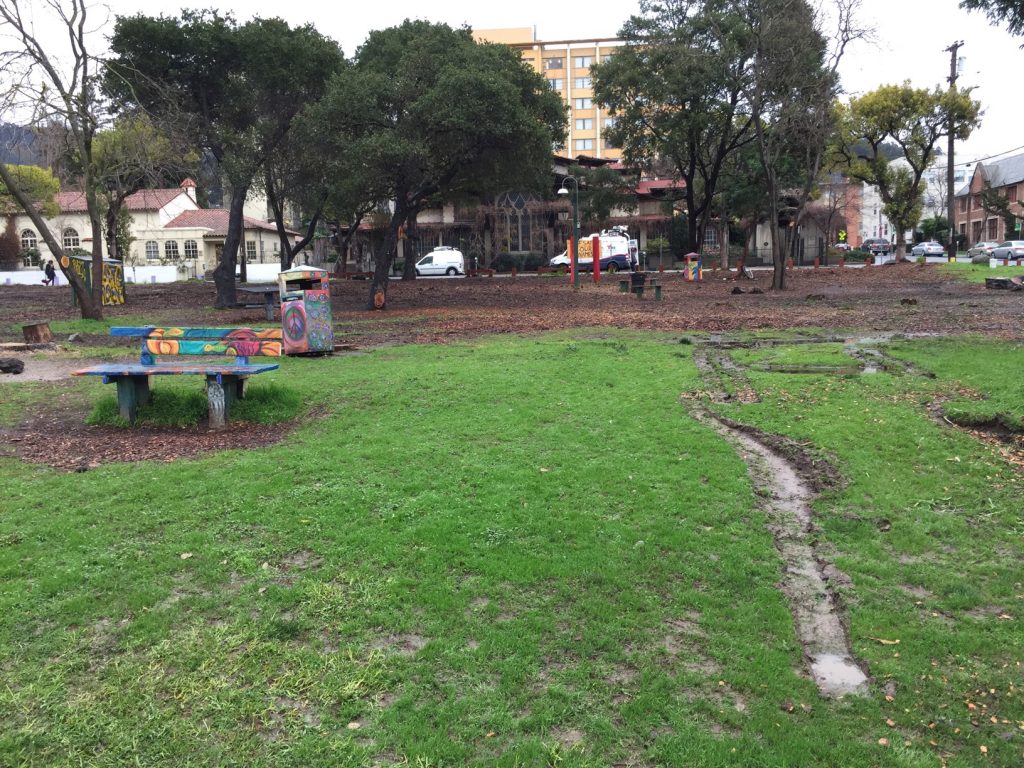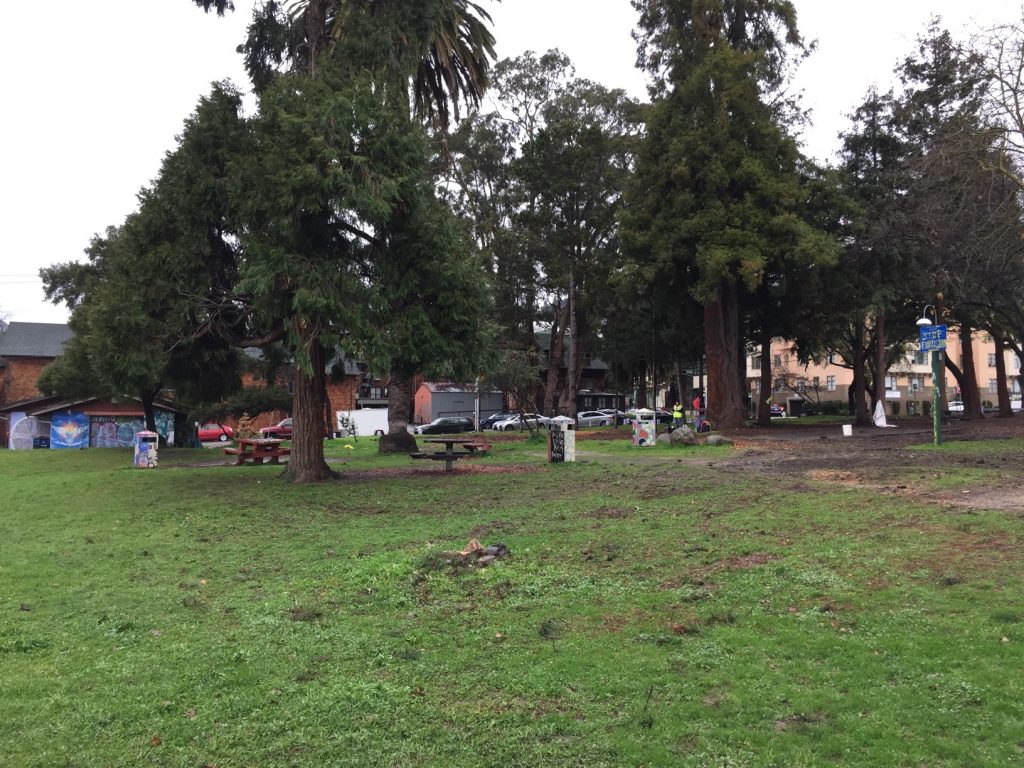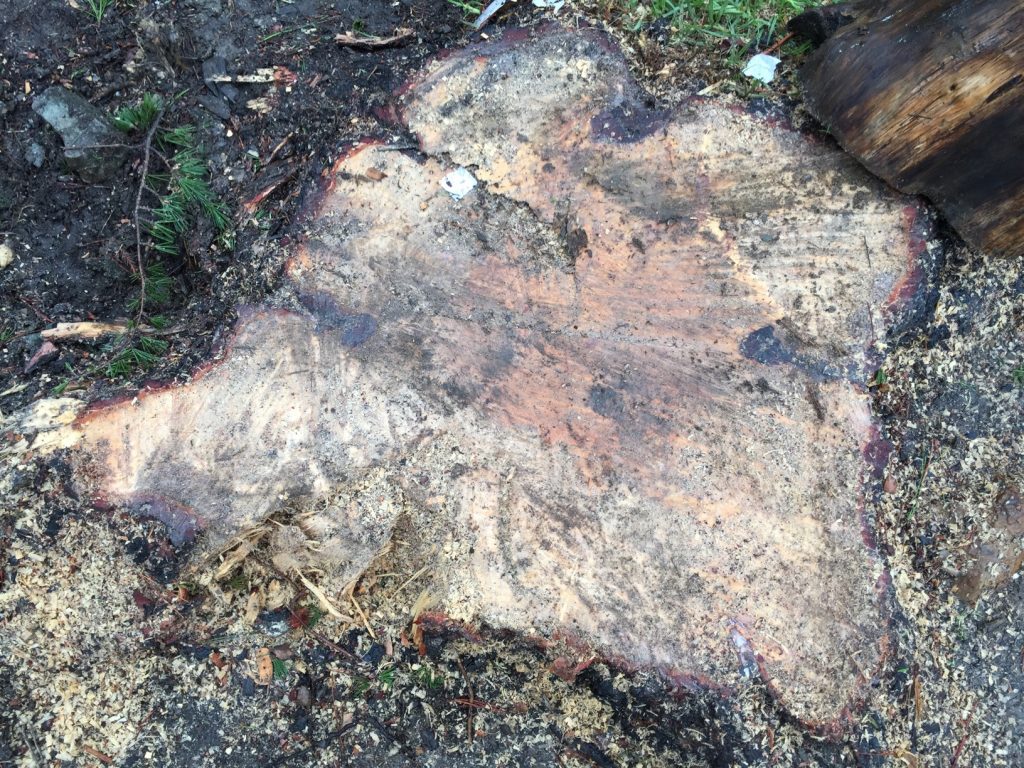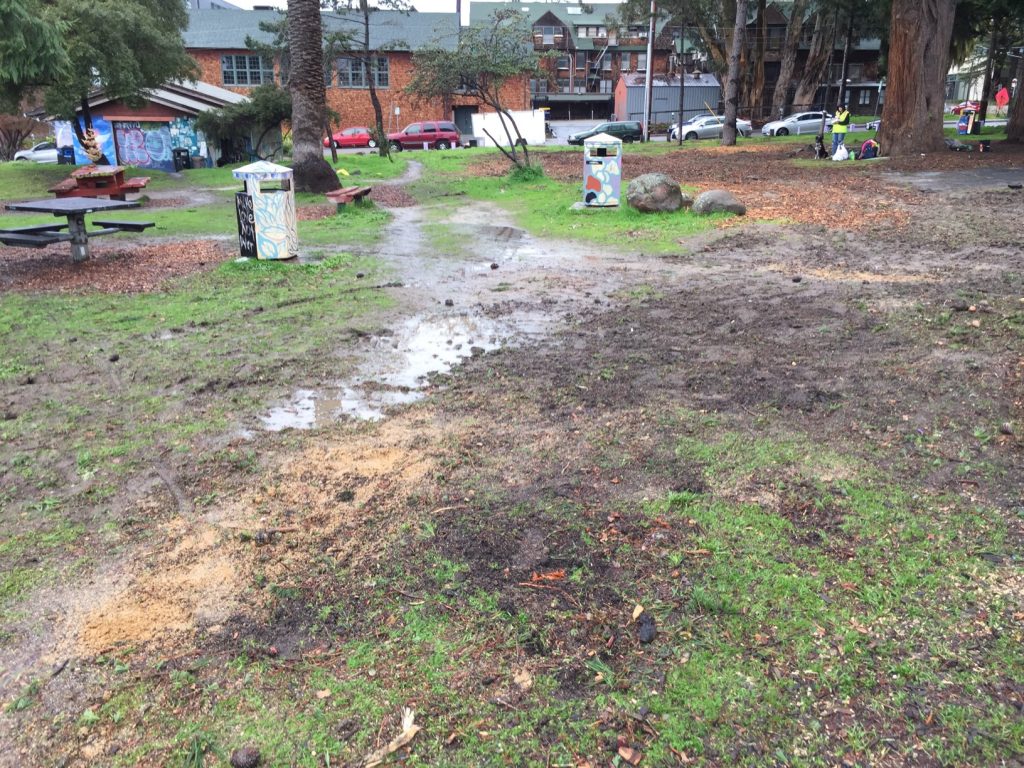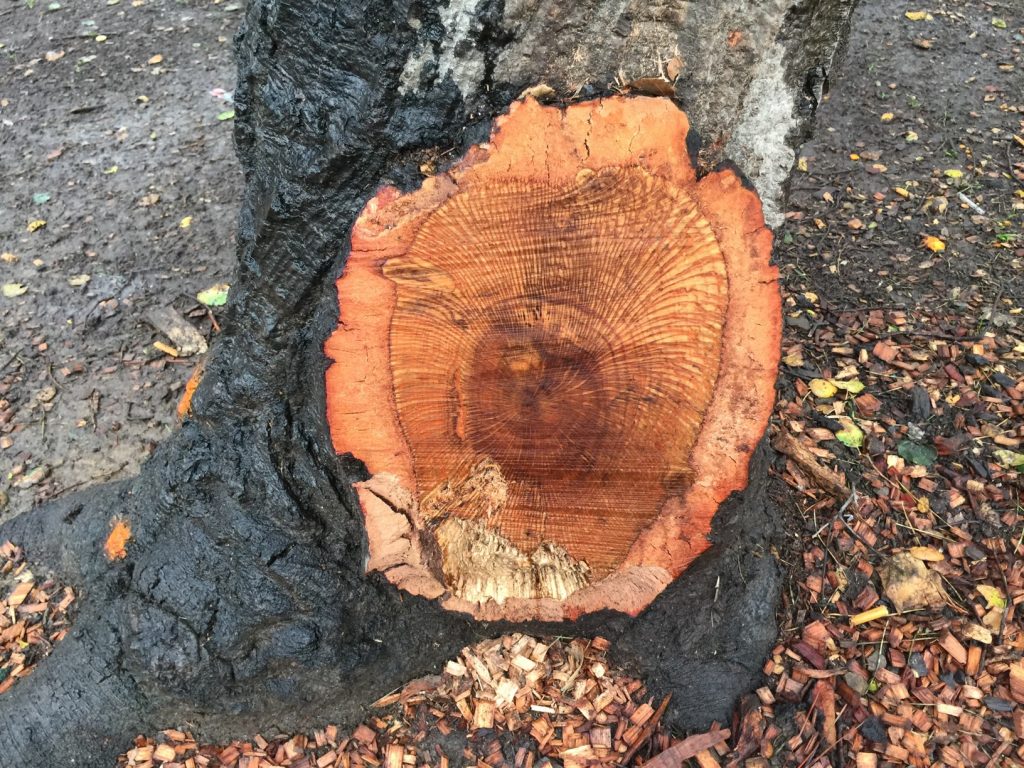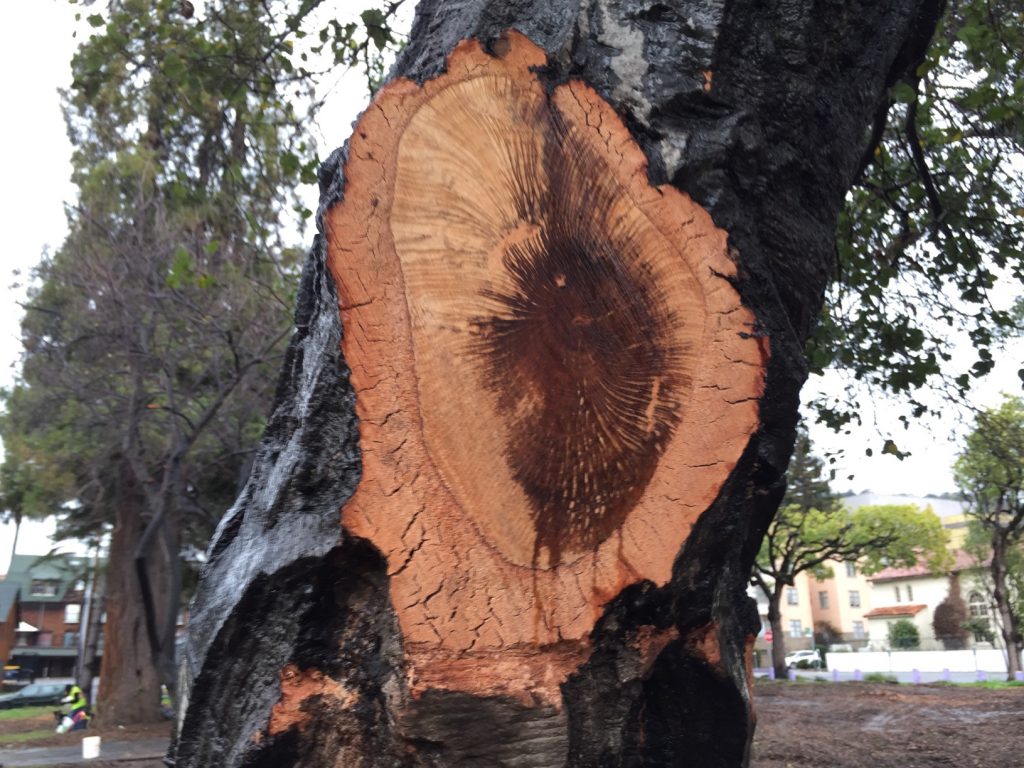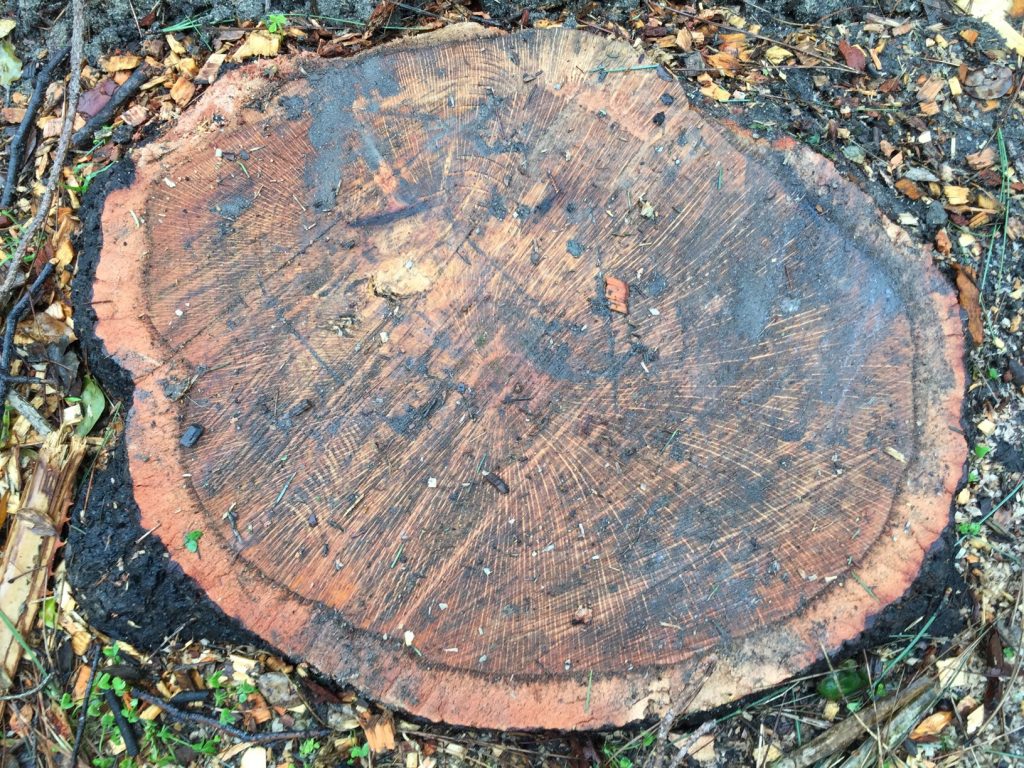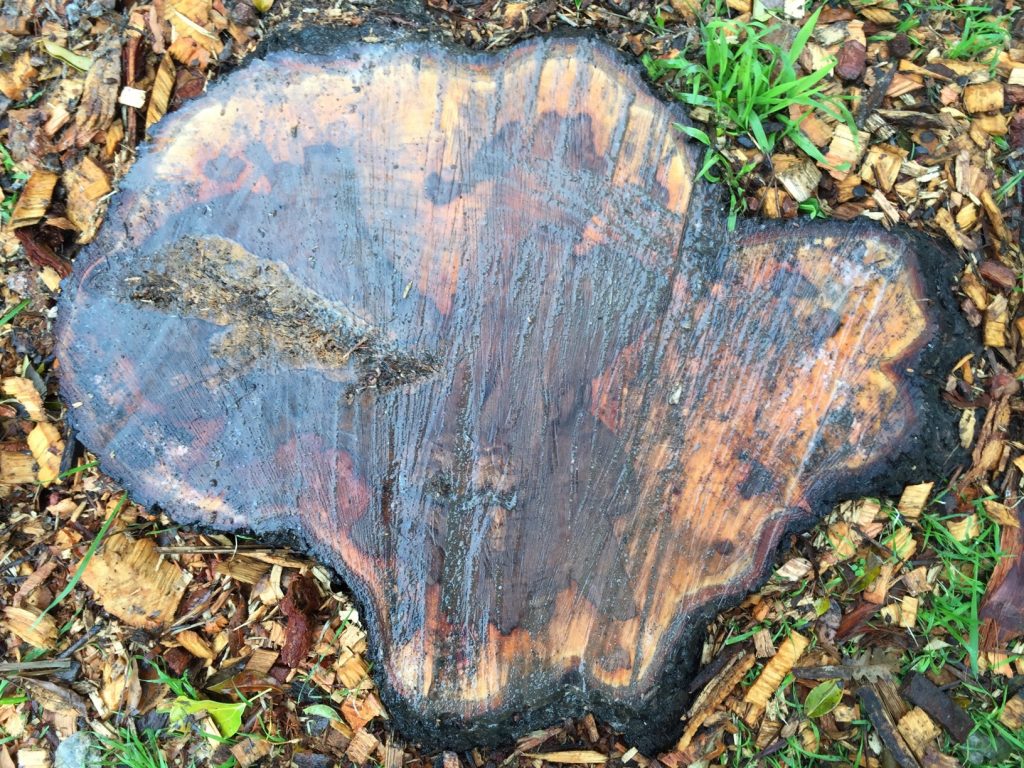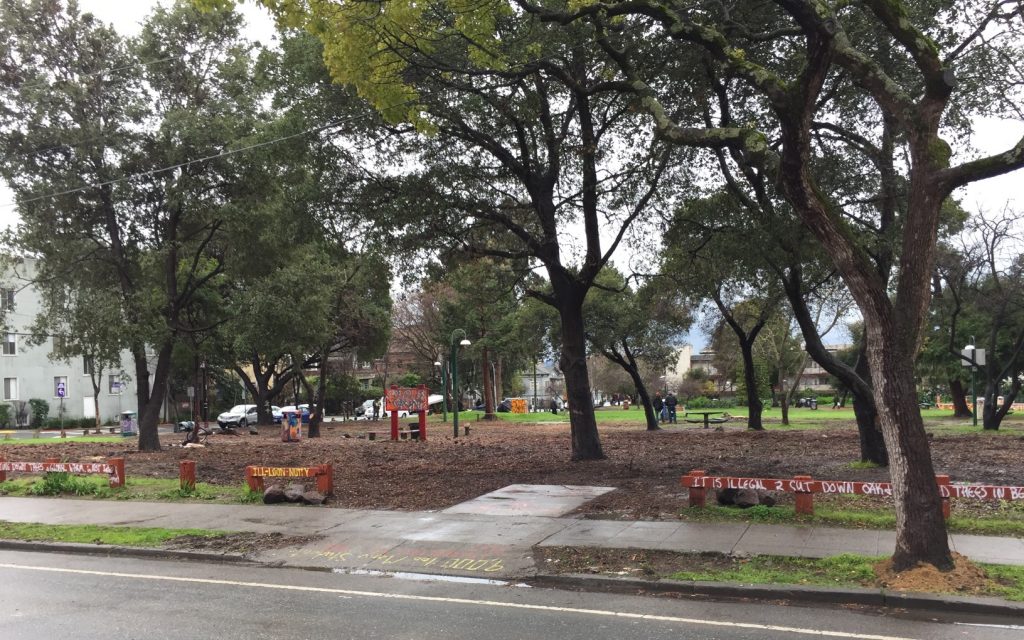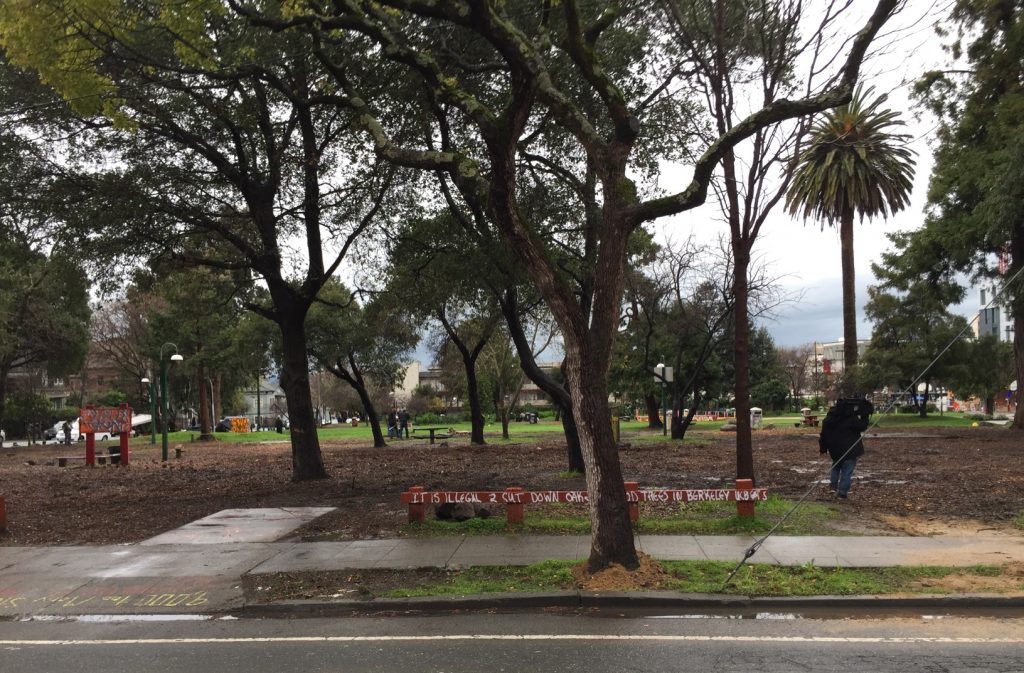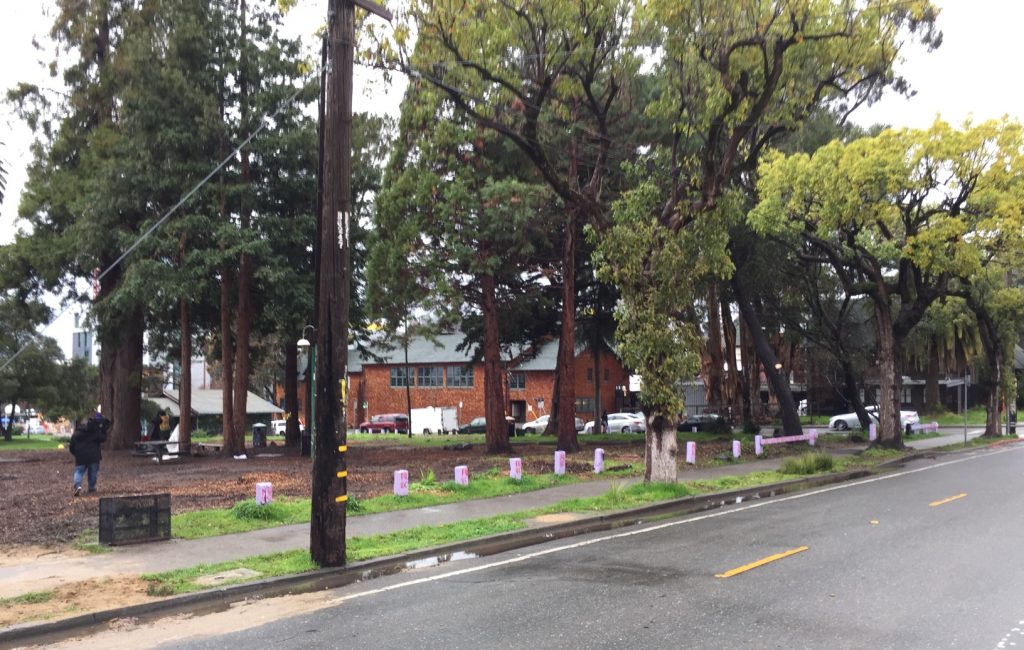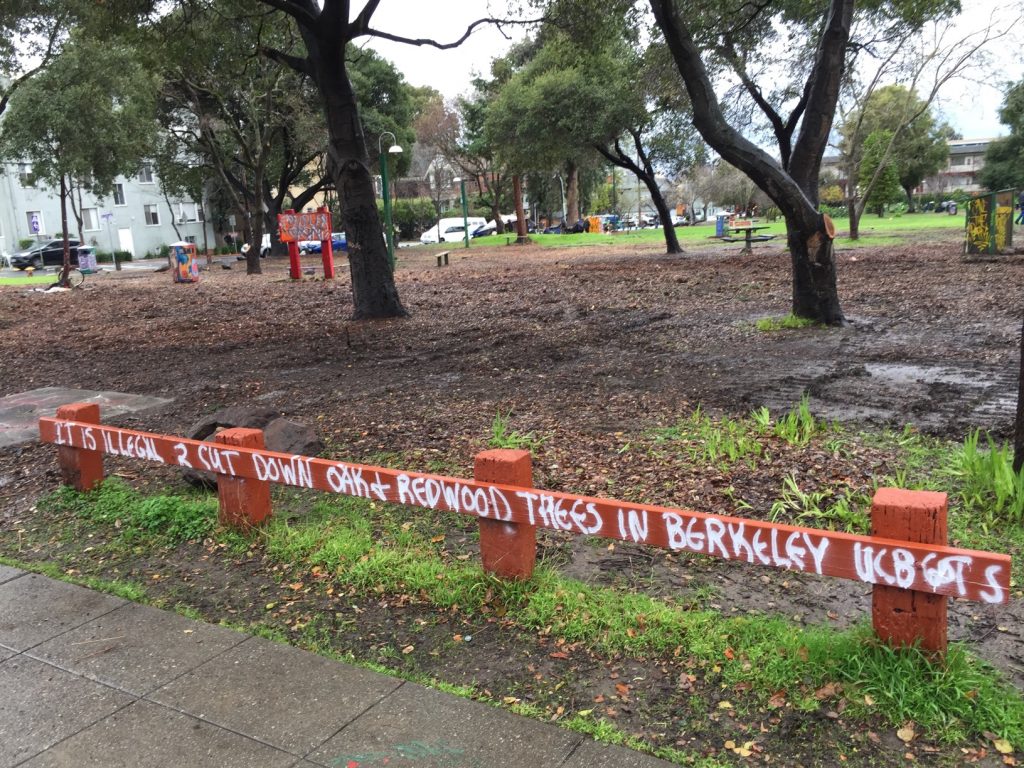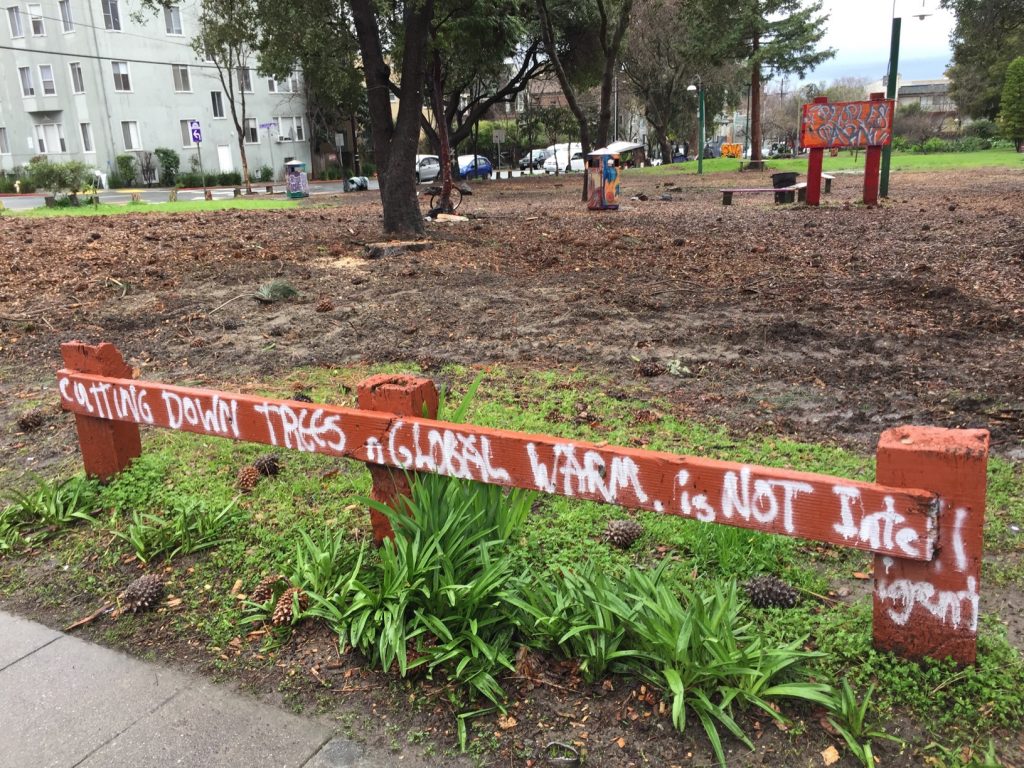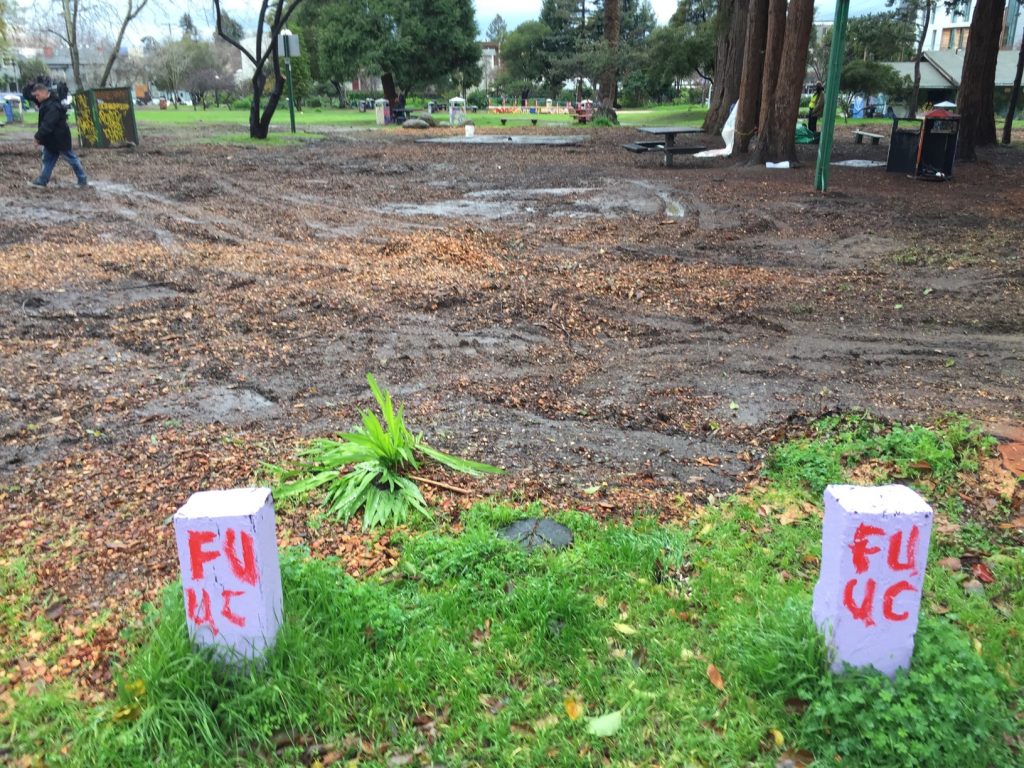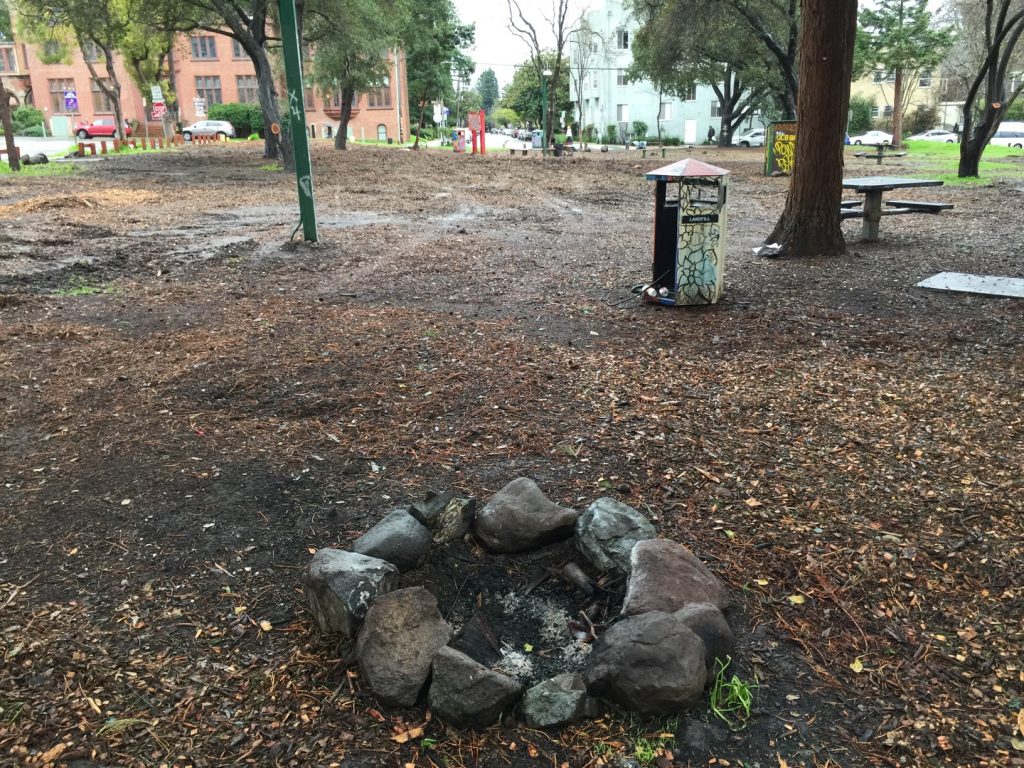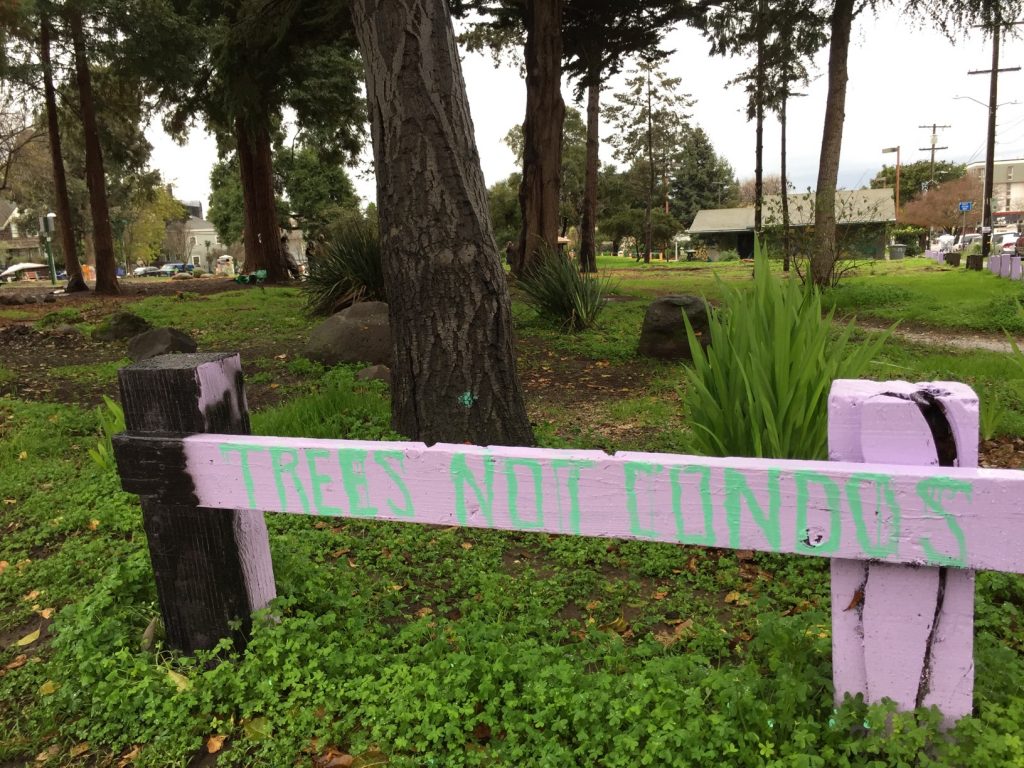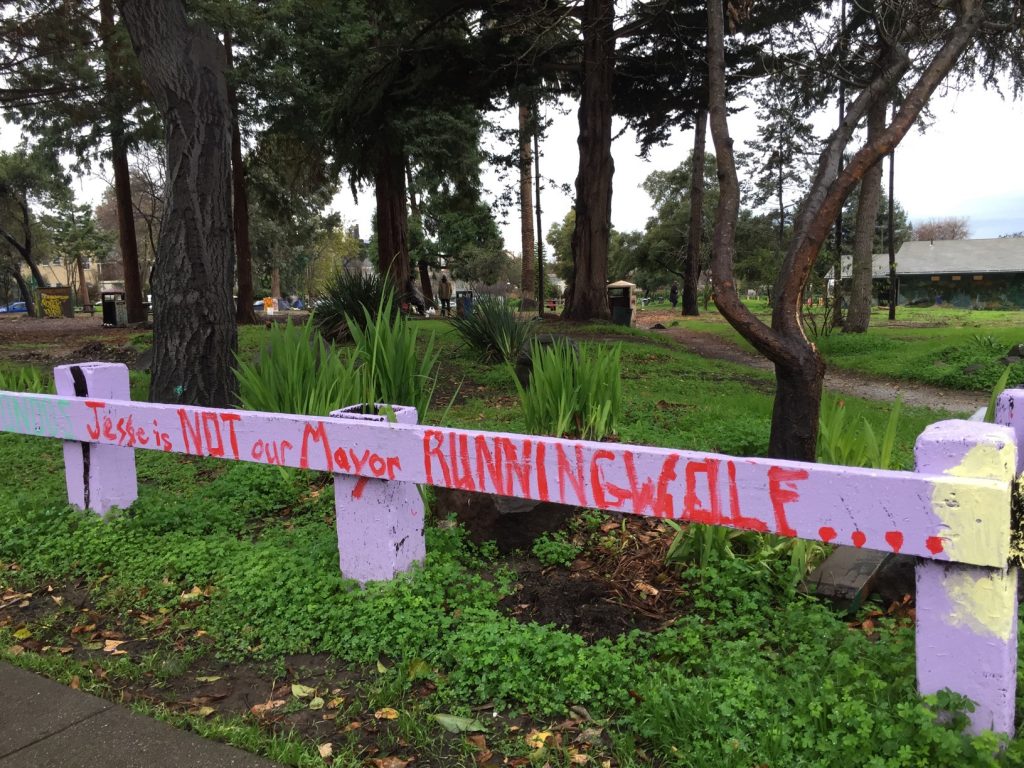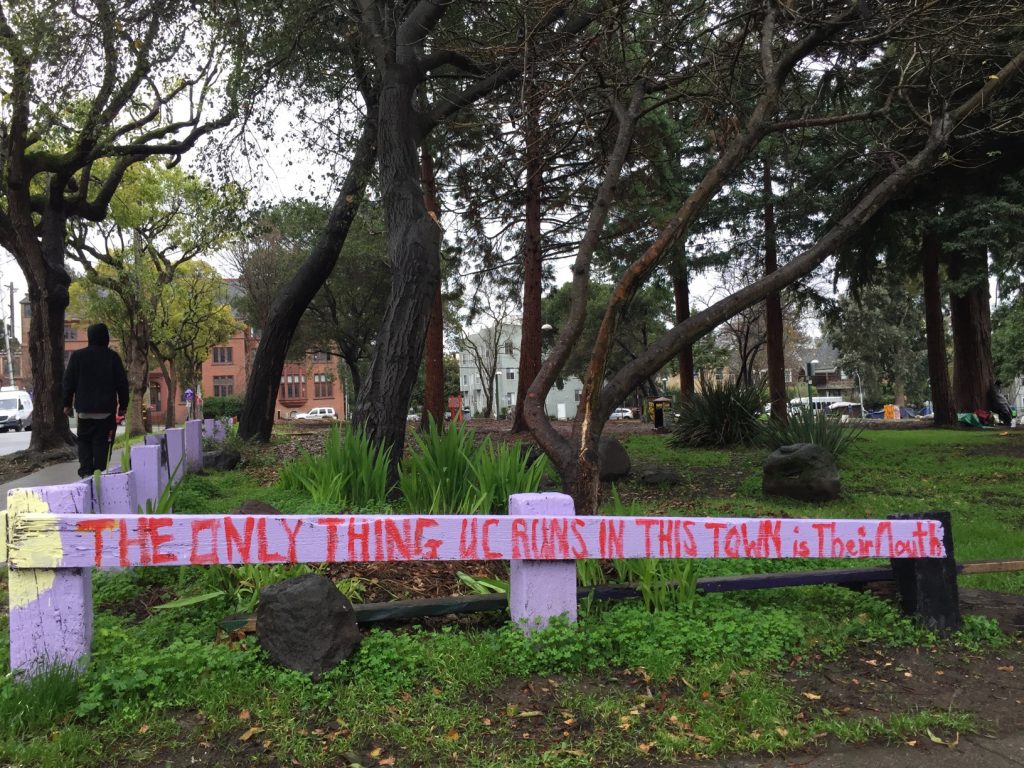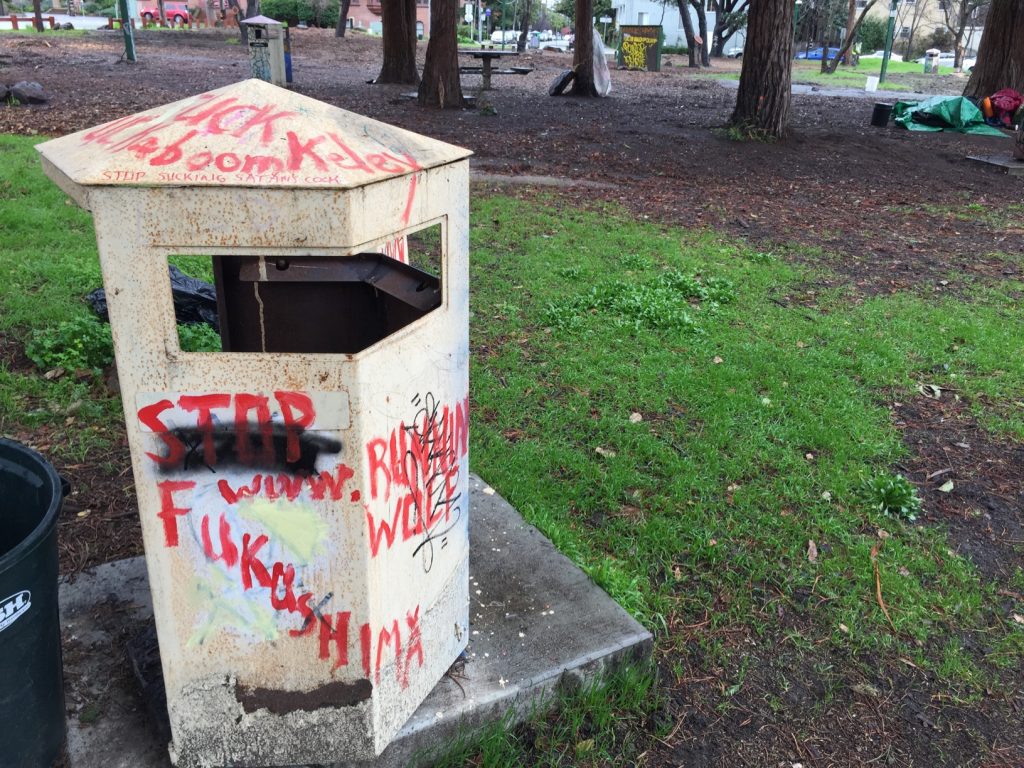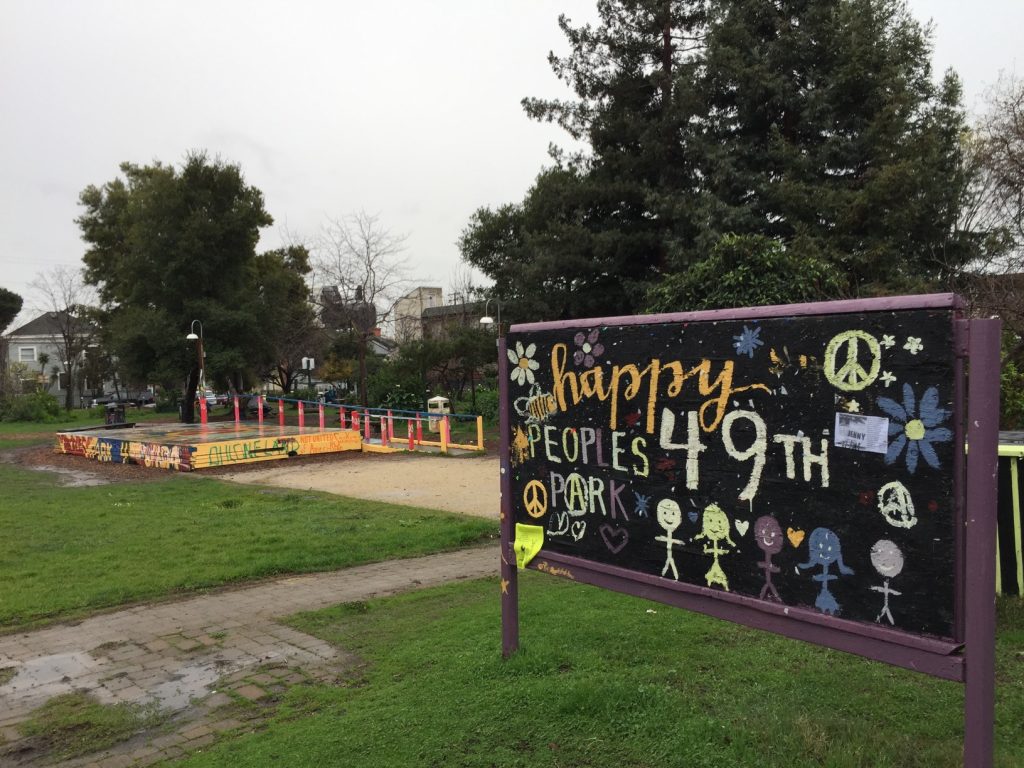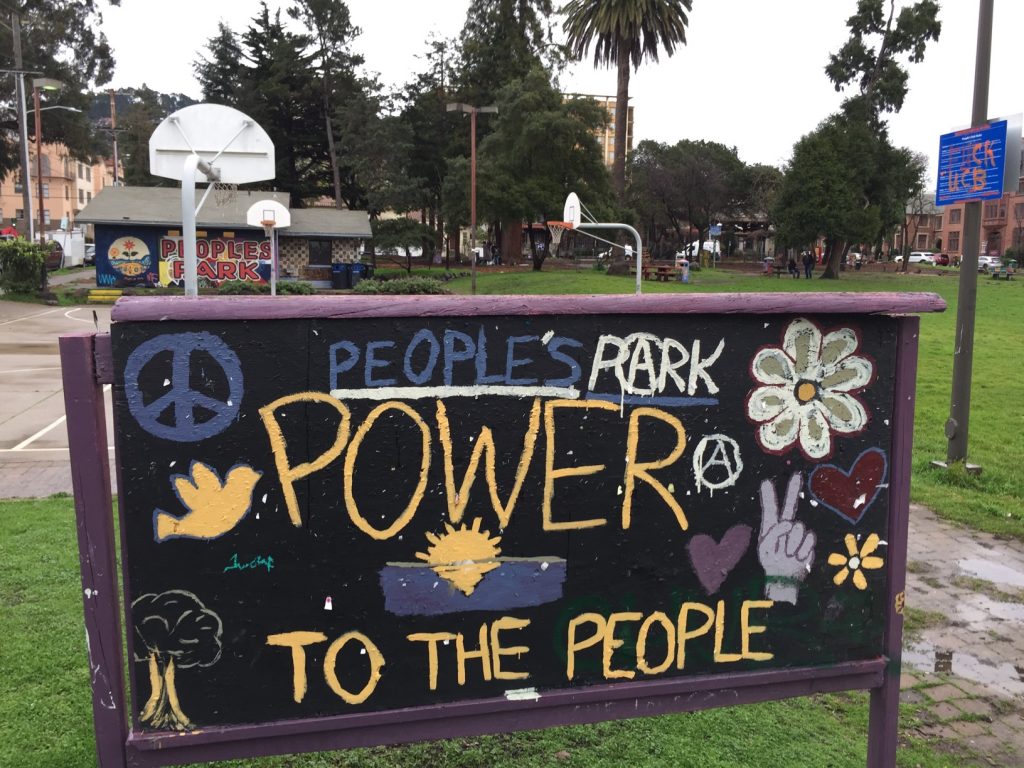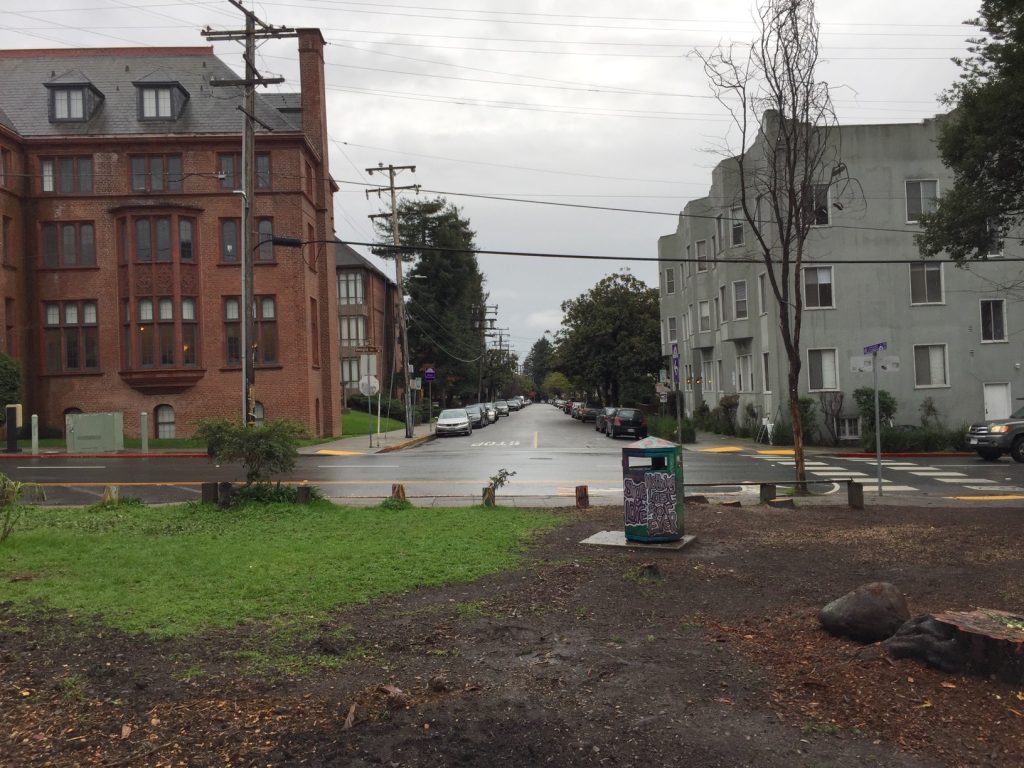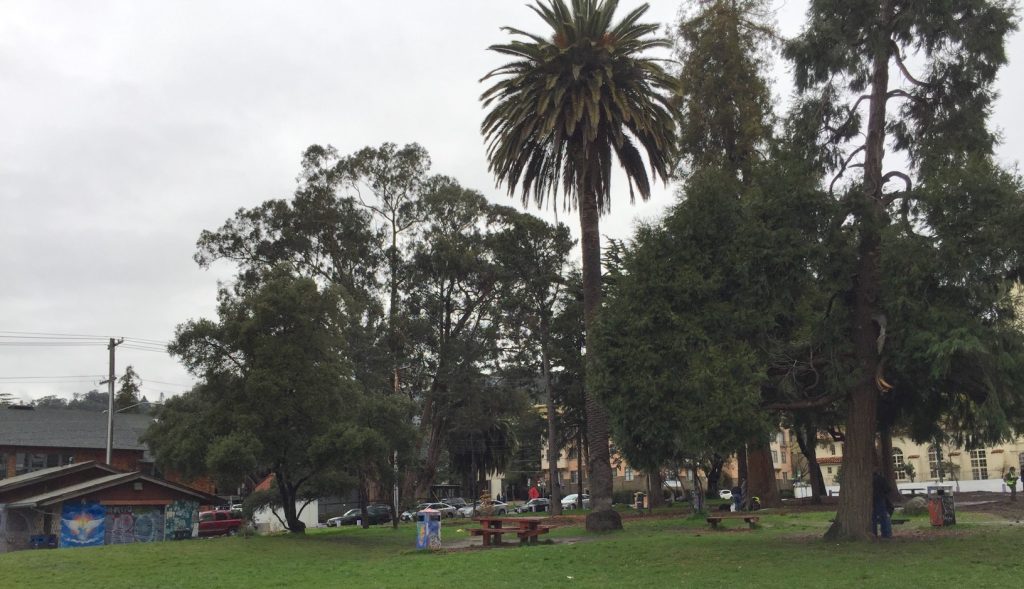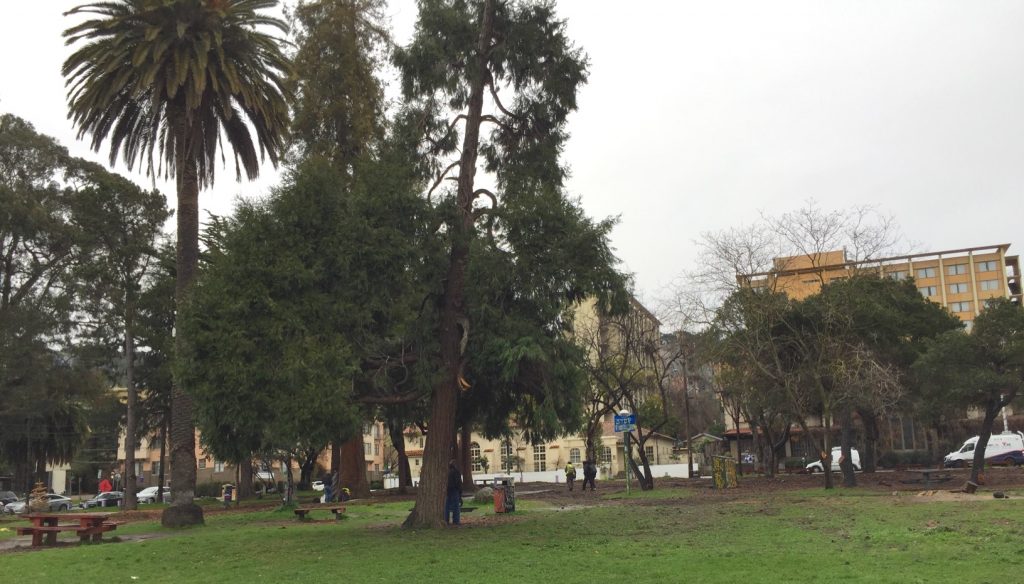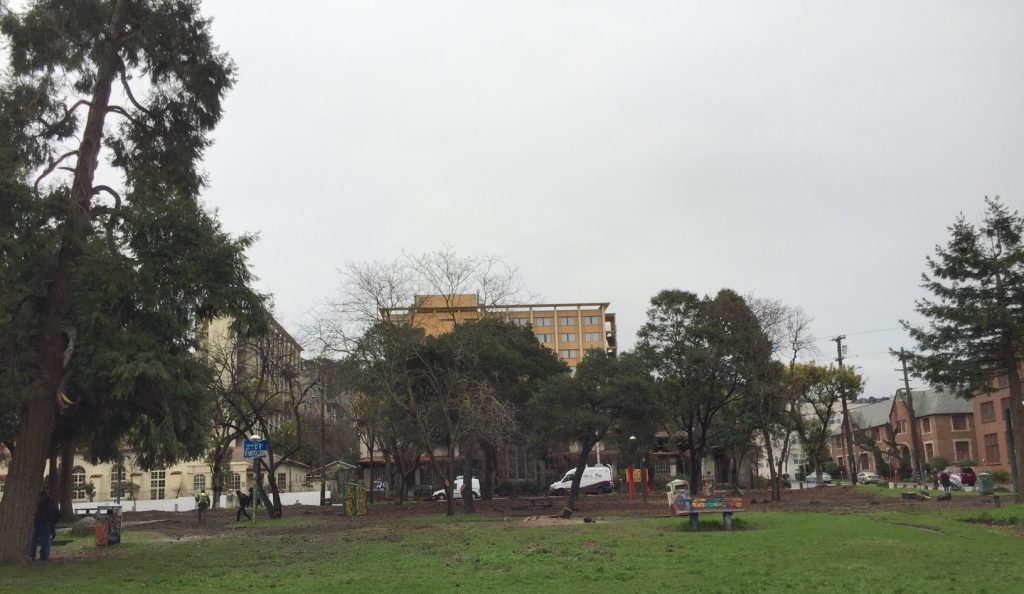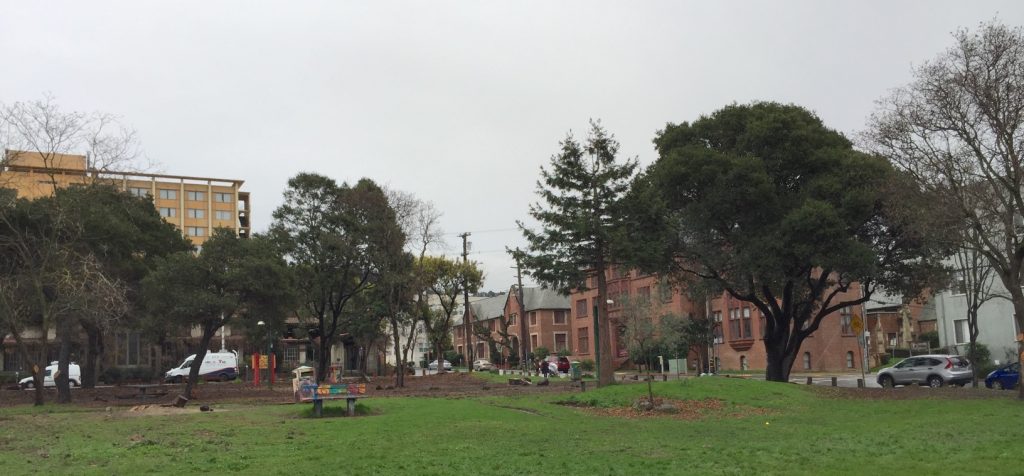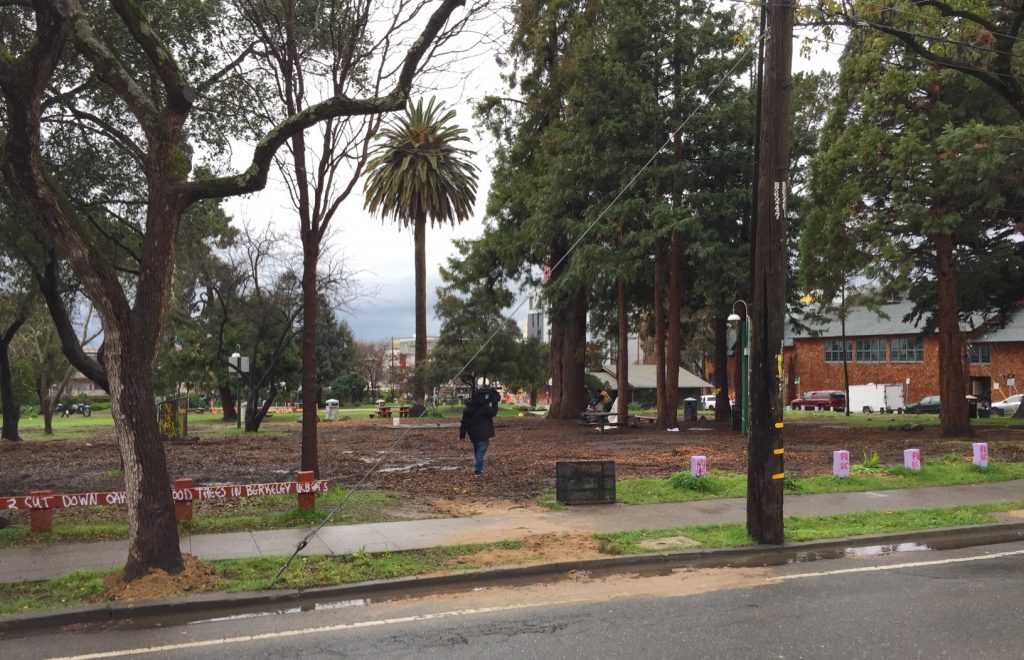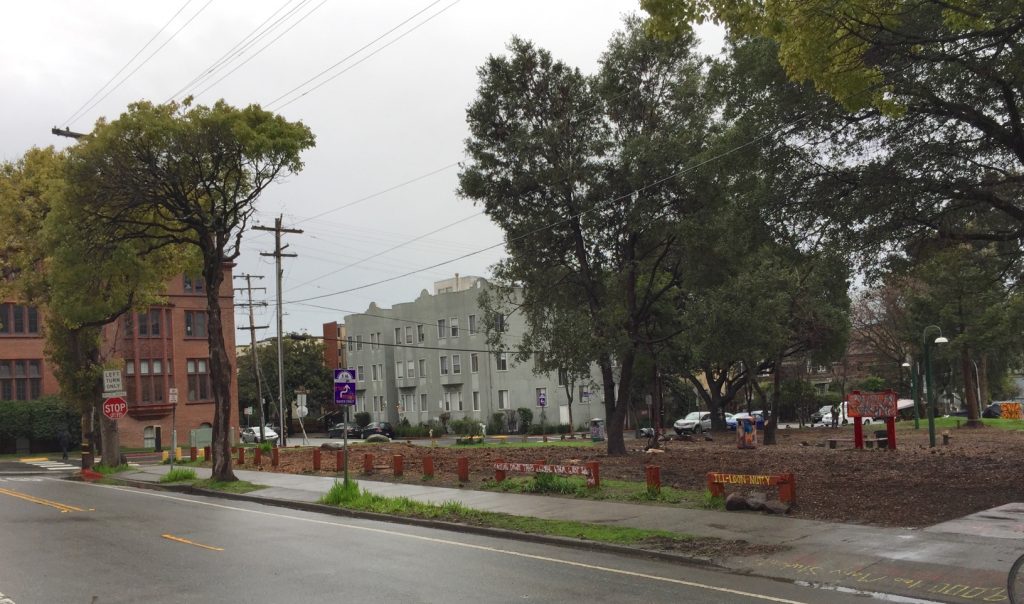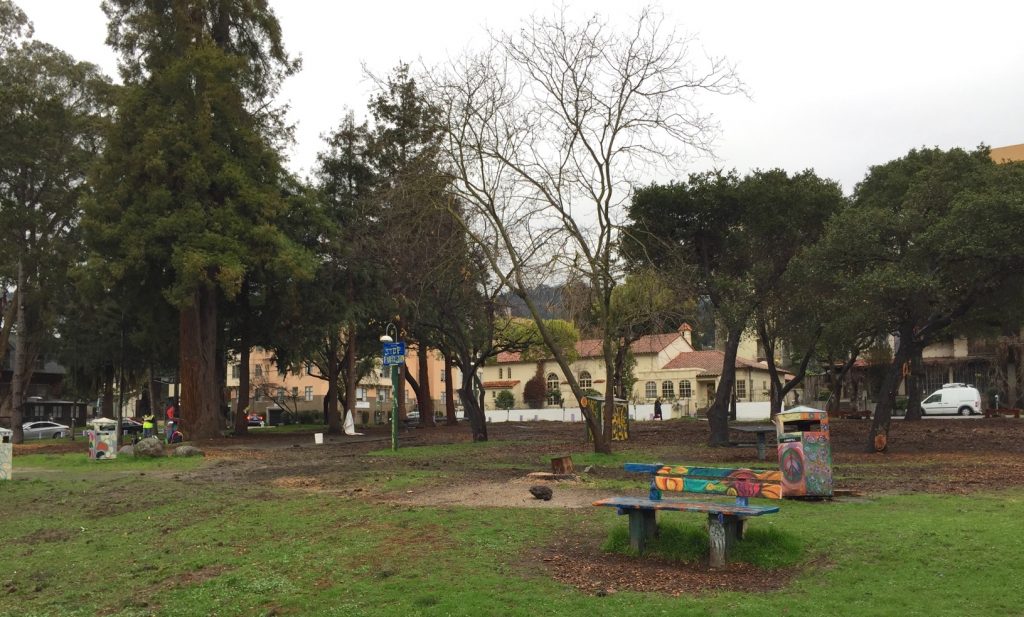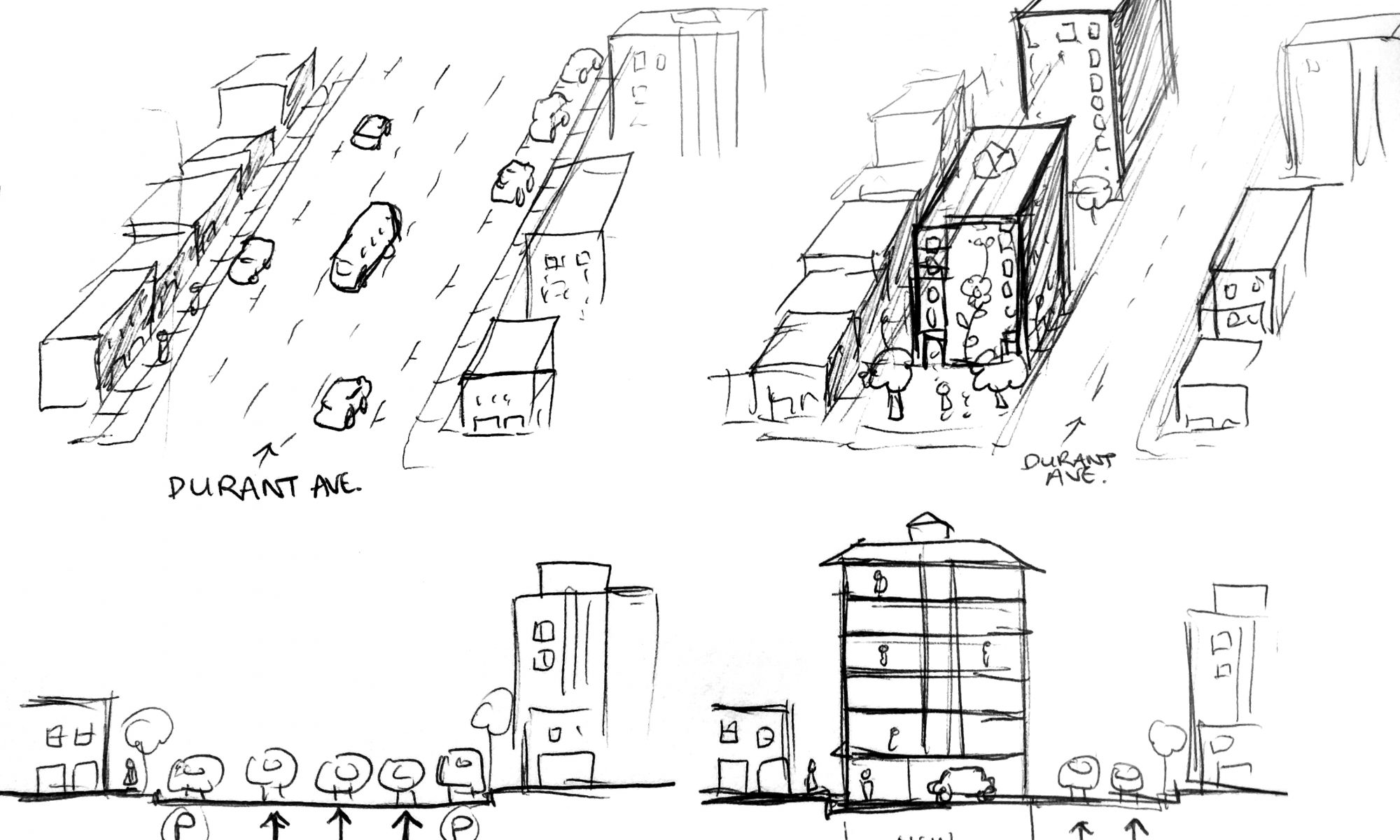Report to the University of California and the People’s Park Community Advisory Board on the Feasibility of Restoring Derby Creek at People’s Park, Berkeley, California. From June 20, 1998.
New People’s Park bathroom video! Maxina Ventura shows the challenges to hygenic hand washing when using the jailhouse-style sinks in our bathrooms. Video by Sheila Mitra Sarkar, April 3, 2020.
New Bulldozer Alarm!
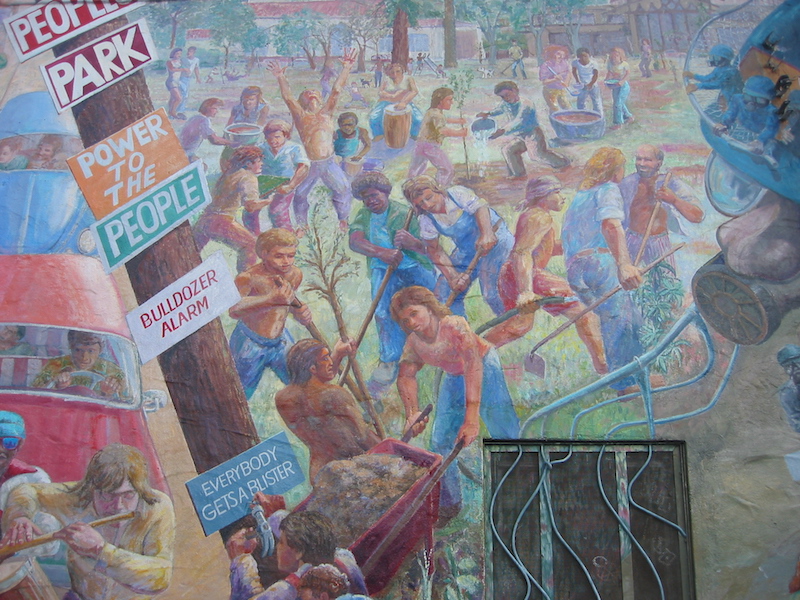
People’s Park now has a Bulldozer Alarm and text alert system so we can let folks know quickly if the Park comes under imminent threat of being fenced, having trees cut down, or literally being bulldozed.
Text SAVETHEPARK to 81257! You will be notified by text if there are threats to People’s Park and/or if we need folks to show up right away!
SAVETHEPARK!
An Audio Blast From the Past — The formation of People’s Park
Here’s an audio montage Robert A. Beede put together from radio music and dialog from the time of the formation of People’s Park.
This site contains copyrighted material the use of which has not always been specifically authorized by the copyright owner. We are making such material available in our efforts to advance understanding of environmental, political, human rights, economic, democracy, scientific, and social justice issues, etc. We believe this constitutes a ‘fair use’ of any such copyrighted material as provided for in section 107 of the US Copyright Law. In accordance with Title 17 U.S.C. Section 107, the material on this site is distributed without profit to those who have expressed a prior interest in receiving the included information for research and educational purposes. For more information go to: http://www.law.cornell.edu/uscode/17/107.shtml. If you wish to use copyrighted material from this site for purposes of your own that go beyond ‘fair use’, you must obtain permission from the copyright owner.
Gardening and Urban Planning
Gardening can function as a way to reprogram the mind and activity patterns away from the patterns imposed by exploitative architecture, transportation, and urban design paradigms. Food production is the basis of our life, yet the city’s design dysfunction is the denial of that basis, replacing it with capitalist enterprising based on selling transportation gear and construction projects, a “boxing in” of the human mind and imagination.
Some people have “Long Range Development Plans”. Do these people have real estate business interests? Construction industry interests? Academia business interests? Student loan business interests? Other interests? Undisclosed interests?
Long Range Development Plan – Thoughts, context, and questions:
Who’s development plan? On whose behalf? Corrupted by what special interests, industries, competing corporations, dystopian paradigms? More pathological air and noise pollution from predatory auto industry prowlers and ‘status symbol’ cruising, and everyone else trapped in automobile dependent urban transport and architecture paradigms? More space wasted on parking? More real estate robots and construction industry interests replicating vanity architecture disguised as necessity and authority? More destruction of green space by academic profiteering and rent exploitation? Is there ever any new green space reclaimed from the insane delusions of urban ‘human’ robots? How can money be seen as power when it seems to only be used to perpetuate and create more dystopia? The externalized costs of fossil fuel usage (climate breakdown, pollution, direct and indirect health damages and cleanup costs not paid for by the industry) are gravely damaging our present and future. People have become puppets of the designs of industrialists, constantly moving their metal boxes from parking space to parking space. The dependency is now becoming a terminal global ‘disease’. When will this pathological behavior and design be shutdown for the collective crime that it is? Who inside and outside of any entity, be it a university, a government, a neighborhood, a business, a church, or any kind of organization or group, is perpetuating this pathological design and activity?
People’s Park is at a point in time and part of a huge collection of other physical elements in an urban transformation. How will all the elements transform, and why?
Background context:
Internal Combustion book – Edwin Black
http://internalcombustionbook.com
Concrete: the most destructive material on Earth
After water, concrete is the most widely used substance on the planet. But its benefits mask enormous dangers to the planet, to human health – and to culture itself
https://www.theguardian.com/cities/2019/feb/25/concrete-the-most-destructive-material-on-earth
Bonobo : Cirrus — This animation depicts the insane propagation of human industrialist construction and materialism across the landscape.
Books:
EcoCities: Rebuilding Cities in Balance with Nature book – Richard Register
Ecocity Builders
https://ecocitybuilders.org
How to Grow More Vegetables book – John Jeavons
Natural Capitalism book – Paul Hawkin, Amory Lovins, L. Hunter Lovins
People’s Park Still Blooming book – Terri Compost
Seed to Seed book – Suzanne Ashworth
Permaculture: A Designer’s Manual book – Bill Mollison
Natural Capitalism book excerpt:
2. Reinventing the Wheels: Hypercars and Neighborhoods – Natural Capitalism
http://www.natcap.org
The largest industry in the world, automotive transportation, is already well along the way to a Factor Four or greater breakthrough in resource productivity. It is also beginning to close its materials loops by adopting durable materials that can be continuously reused to make new cars, and to reduce dramatically its pressure on air, climate, and other key elements of natural capital by completely rethinking how to make a car move. This restructuring of so well established a segment of the economy is gaining its momentum not from regulatory mandates, taxes, or subsidies but rather from newly unleashed forces of advanced technology, customer demands, competition, and entrepreneurship.
Imagine a conversation taking place at the end of the nineteenth century. A group of powerful and farseeing businessmen announce that they want to create a giant new industry in the United States, one that will employ millions of people, sell a copy of its product every two seconds, and provide undreamed-of levels of personal mobility for those who use its products. However, this innovation will also have other consequences so that at the end of one hundred years, it will have done or be doing the following:
• paved an area equal to all the arable land in the states of Ohio, Indiana, and Pennsylvania, requiring maintenance costing more than $200 million per day;
• reshaped American communities and lives so as to restrict the mobility of most citizens who do not choose or are not able to own and operate the new product;
• maimed or injured 250 million people, and killed more Americans than have died in all wars in the country’s history;
• be combusting 8 million barrels of oil every day (450 gallons per person annually);
• made the United States increasingly dependent on foreign oil at a cost of $60 billion a year;
• relied for an increasing percentage of that oil on an unstable and largely hostile region armed partly by American oil payments, requiring the United States to make large military expenditures there and maintain continual war-readiness;
• be killing a million wild animals per week, from deer and elk to birds, frogs, and opossums, plus tens of thousands of domestic pets;
• be creating a din of noise and a cloud of pollution in all metropolitan areas, affecting sleep, concentration, and intelligence, making the air in some cities so unbreathable that children and the elderly cannot venture outside on certain days;
• caused spectacular increases in asthma, emphysema, heart disease, and bronchial infections;
• be emitting one-fourth of U.S. greenhouse gases so as to threaten global climatic stability and agriculture;
• and be creating 7 billion pounds of unrecycled scrap and waste every year.
Now imagine they succeeded.
This is the automobile industry—a sector of commerce so massive that in 1998, five of the seven largest U.S. industrial firms produced either cars or their fuel. If this industry can fundamentally change, every industry can. And change it will. This chapter describes how the world’s dominant business is transforming itself to become profoundly less harmful to the biosphere.
That transformation reflects, today partially and soon fully, the latest in a long string of automotive innovations. In 1991, a Rocky Mountain Institute design called the Hypercar synthesized many of the emerging automobile technologies. To maximize competition and adoption, the design was put in the public domain (making it unpatentable), hoping this would trigger the biggest shift in the world’s industrial structure since microchips. As revolutions go, it started quietly, with simple observations and heretical ideas.
The automobile industry of the late twentieth century is arguably the highest expression of the Iron Age. Complicated assemblages of some fifteen thousand parts, reliable across a vast range of conditions, and greatly improved in safety and cleanliness, cars now cost less per pound than a McDonald’s Quarter Pounder. Yet the industry that makes them is overmature, and its central design concept is about to be overtaken. Its look-alike products fight for small niches in saturated core markets; they’re now bought on price via the Internet like file cabinets, and most dealers sell new cars at a loss. Until the mid-1990s, the industry had become essentially moribund in introducing innovation. As author James Womack has remarked, “You know you are in a stagnant industry when the big product innovation of the past decade is more cup holders.” Virtually all its gains in efficiency, cleanliness, and safety have been incremental and responded to regulations sought by social activists. Its design process has made cars ever heavier, more complex, and usually costlier. These are all unmistakable signs that automaking had become ripe for change. By the 1990s, revolutions in electronics, software, materials, manufacturing, computing, and other techniques had made it possible to design an automobile that would leapfrog far beyond ordinary cars’ limitations.
The contemporary automobile, after a century of engineering, is embarrassingly inefficient: Of the energy in the fuel it consumes, at least 80 percent is lost, mainly in the engine’s heat and exhaust, so that at most only 20 percent is actually used to turn the wheels. Of the resulting force, 95 percent moves the car, while only 5 percent moves the driver, in proportion to their respective weights. Five percent of 20 per-cent is one percent—not a gratifying result from American cars that burn their own weight in gasoline every year.
peoplespark.org has a huge photo collection in various categories, gardens, music, art, style, history, and numerous event announcements and articles about the park and contemporary issues.
—
20th Annual Bay Area Seed Swap
Friday, March 15, 2019, 7:00 pm — 9:00 pm
Ecology Center, 2530 San Pablo Avenue, Berkeley, CA 94702
Join us for the 20th Anniversary of the Annual Seed Exchange hosted by the Bay Area Seed Interchange Library (BASIL). In its 20th year, this swap features speakers, a potluck dinner, and hundreds of seeds to share. Seeds from all around the Bay Area will be available to swap– take home a whole new garden! Come experience one of our most popular, fun, and knowledge- filled events! All are welcome.
Bring seeds and a potluck dish and get in free! Or a suggested donation of $5-$20. No one turned away for lack of funds.
Interested in volunteering at the swap, or helping us sort seeds on March 16? We would love to have your help! Email minna@ecologycenter.org.
Co-sponsored by Indigenous Permaculture Project, Richmond Grows, Sustainable Economies Law Center, and Transition Berkeley.
—
People’s Park gardens photo collection – Greg Jalbert — To be added to peoplespark.org site.
New Landscape: Durant Avenue – Housing / multiuse buildings and mini-parks
Why waste so much space on relatively unused asphalt?
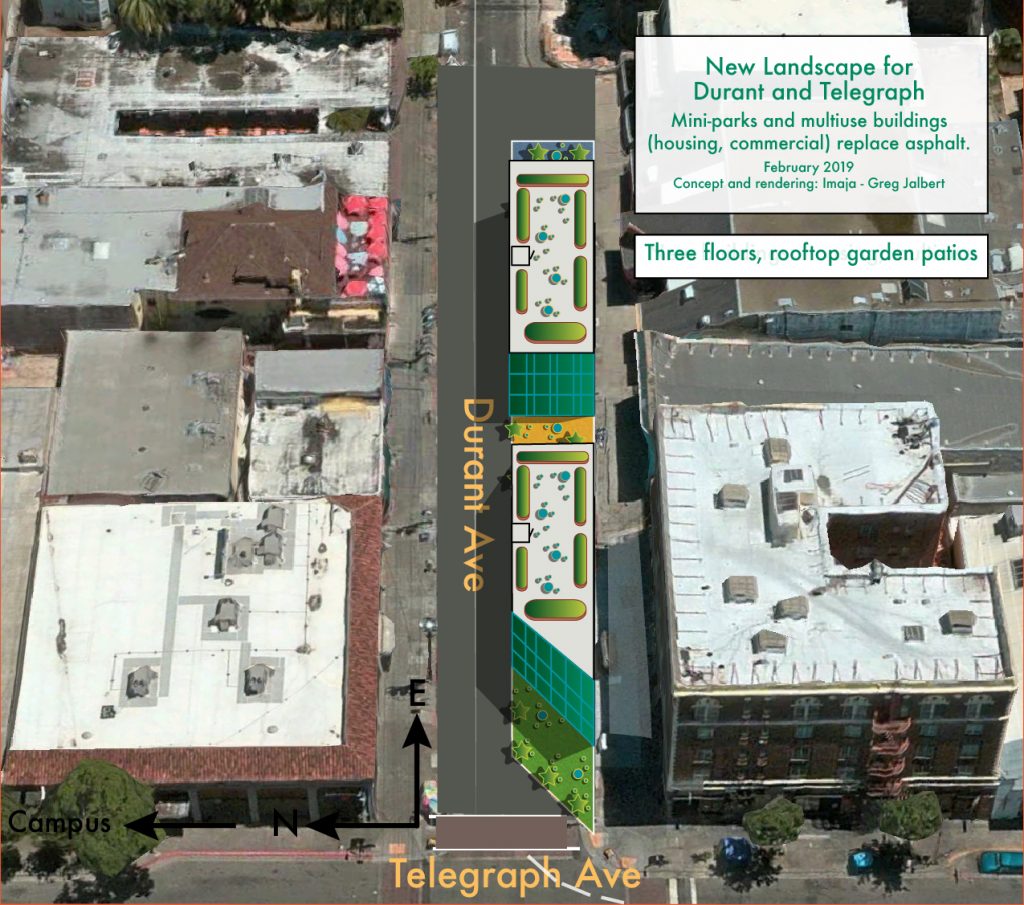
This visionary project creates two new three-story housing / multiuse buildings, interleaved with three mini-parks in part of the wasted asphalt space on Durant Avenue, East of Telegraph, just south of UC Berkeley campus.
A work in progress…
Two three-story buildings between the mini-parks have housing on the quieter South side, away from Durant traffic, and the hallways on the North side overlook the noisy Durant traffic.
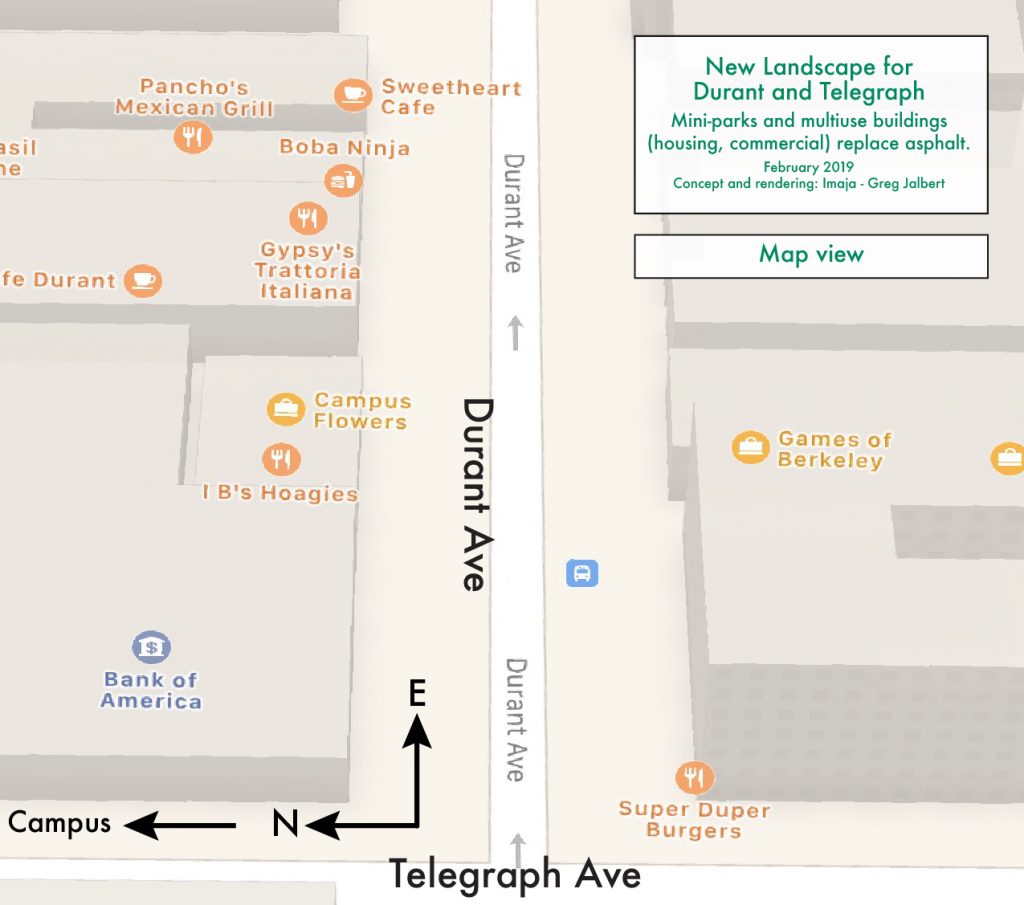
The mini-parks include 3-5 trees each, several moveable tables and benches, providing more outdoor space for dining and socializing. This would be a benefit to all the local restaurants, visitors and residents.
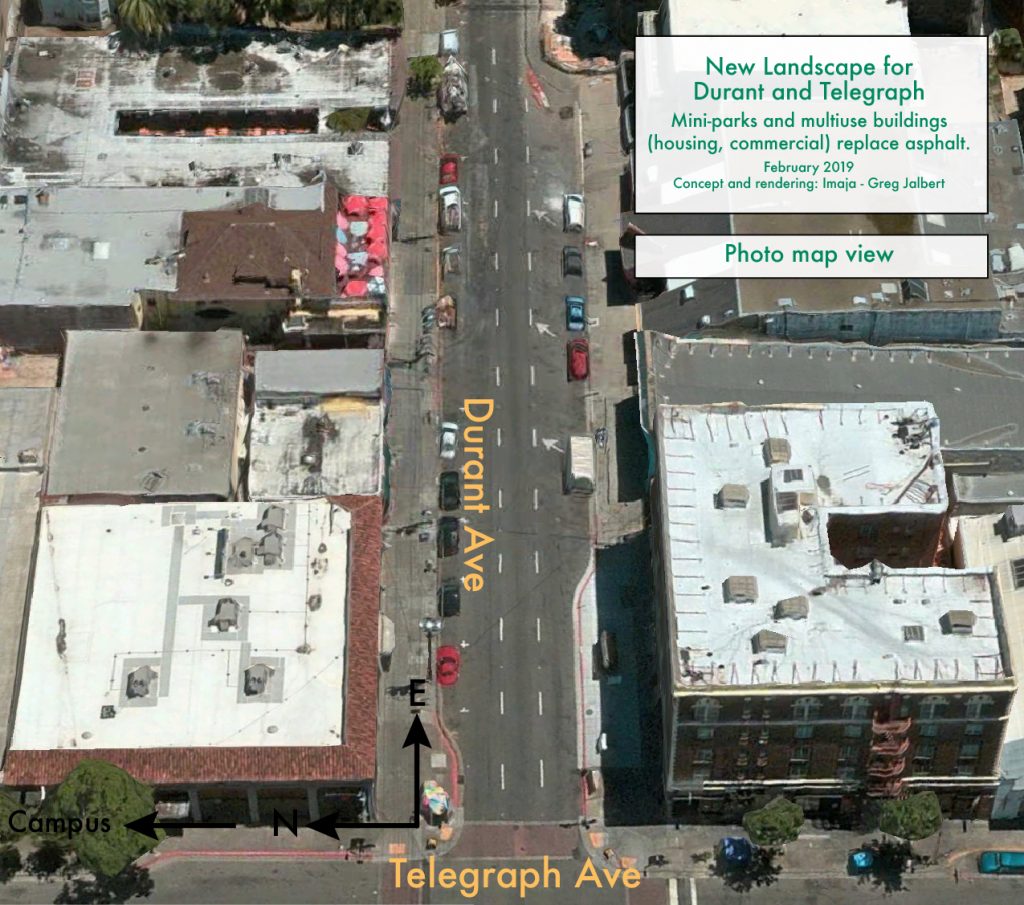
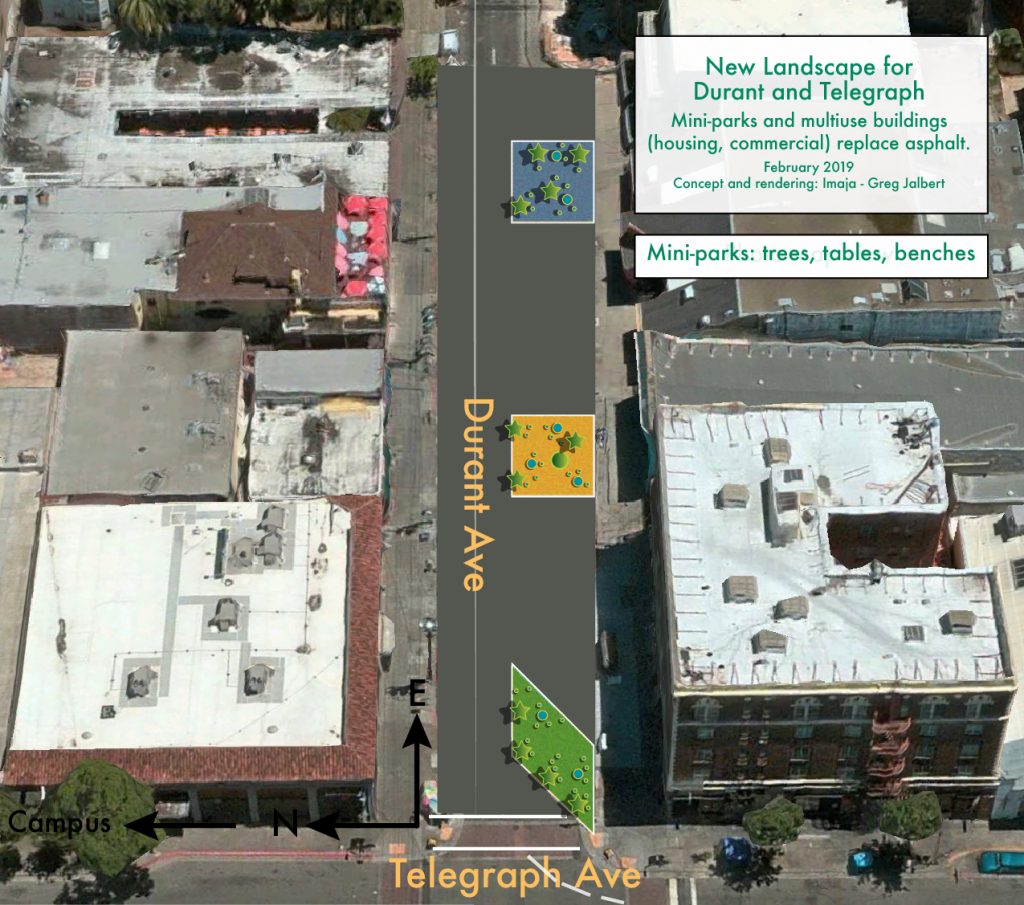
The glass on the South side of the buildings will reflect some sunlight into shadows of the South side of Durant.
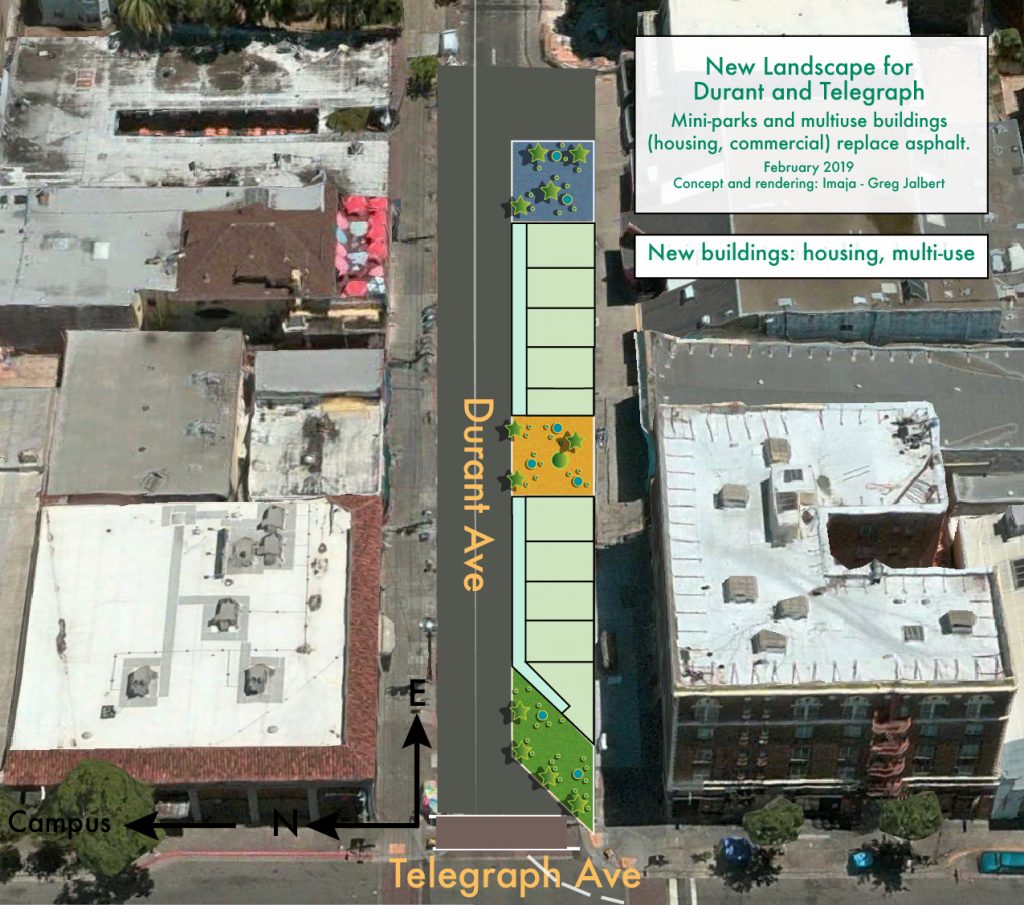
Green, living wall plants on the exterior would provide aesthetic interest and cooling and air-cleansing functions.
Keep the old sidewalks on both sides of Durant and revise as well with outdoor seating, greenery.
The new buildings have appropriate automobile crash barriers built into the first floor wall facing Durant.
Rooftop garden beds, and patios with tables, chairs, wind break walls, and sun shades would increase outdoor space for building users or restaurant users.
The modular housing/park concept could be extended all the way East on Durant to the end of the block, and/or replicated on the block West of Telegraph.
The details of this project, such as building height, unit sizes and quantities, layout, and other logistical and ecological details are all to be determined by qualified designers with full community feedback.
The automobile age is ending. The new lifestyle and design paradigm is about bikes, e-bikes and scooter sharing systems, car-sharing, ride-hailing services, mass-transit and walkable, livable city designs made for people instead of automobiles. Electric bicycles require much less space for parking and are quiet, less distracting for people. Noise is a serious detriment to studying and mental health. The new paradigm releases a large amount of previously paved land for new uses.
Currently five lanes wide with two lanes of parking and three lanes for traffic, this project has part of Durant reduced to two lanes of traffic and no parking.
It is time to protect and increase precious green space in the city, improve quality of life, reorient space use priorities.
This project is designed to reduce loss of public green space parks in the city, such as the historic user-developed multi-use People’s Park in Berkeley. One of the mottos from the founding of People’s Park in 1969 is “Let a thousand parks bloom.” could be inscribed in furniture of the new mini-parks.
Together, creatively, we will make develop better cities and neighborhoods.
— Greg Jalbert
Concept and rendering – Greg Jalbert
Thanks to Alfred Twu for inspiring preliminary sketches!
February 2019
Glorious People’s Park forest rainbow
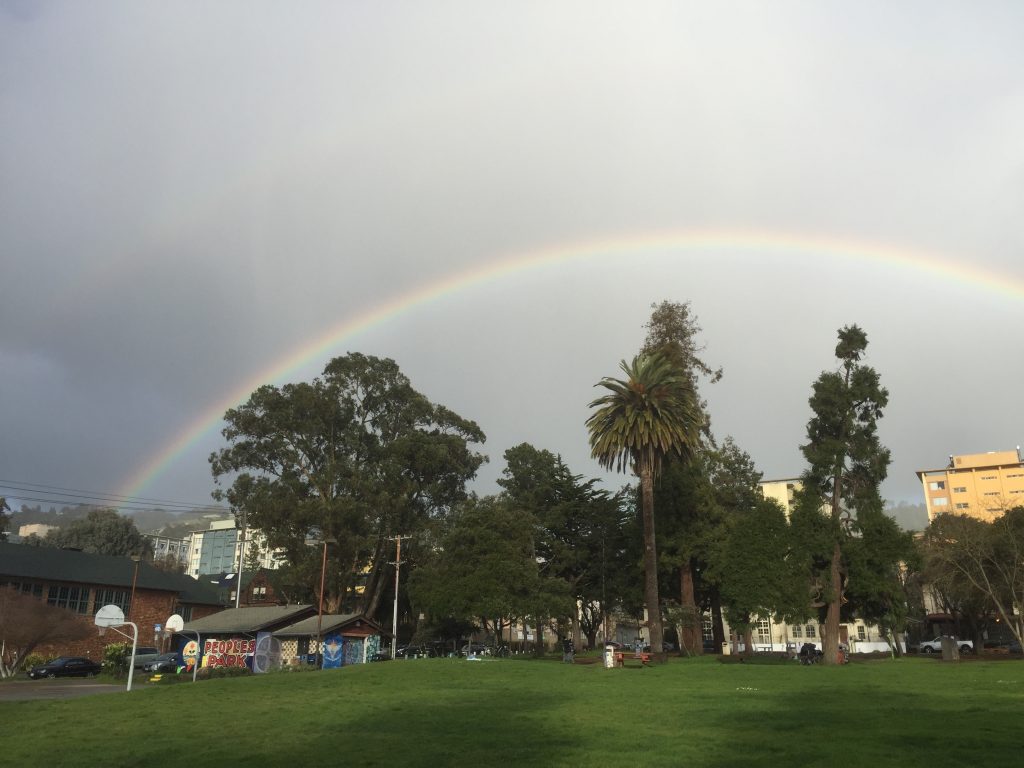
Friday Feb 15, 2019 — All People’s Park visitors got a special treat today with wonderful sunny February rains (a special atmospheric river, a Pineapple Express) and this double rainbow (ya gotta squint a bit) over the beautiful forest of the West side of the park. We really enjoyed it, all jumping out to see the glory, all while listening to a stunning show of Aretha Franklin tunes on KCSM radio and an assortment of reggae and world music items donated to the park. Music stories lead to cultural stories, and lead to wisdom. Sweet dreams. – Greg Jalbert
Tree attack at East-side forest of People’s Park in early morning – January 15, 2019
People’s Park, January 15, 2019 – People’s Park was attacked by tree cutters and many police in the early morning, surrounding trees while chainsaws chopped more living trees from the East-side forest.
Updated with 30 photos.
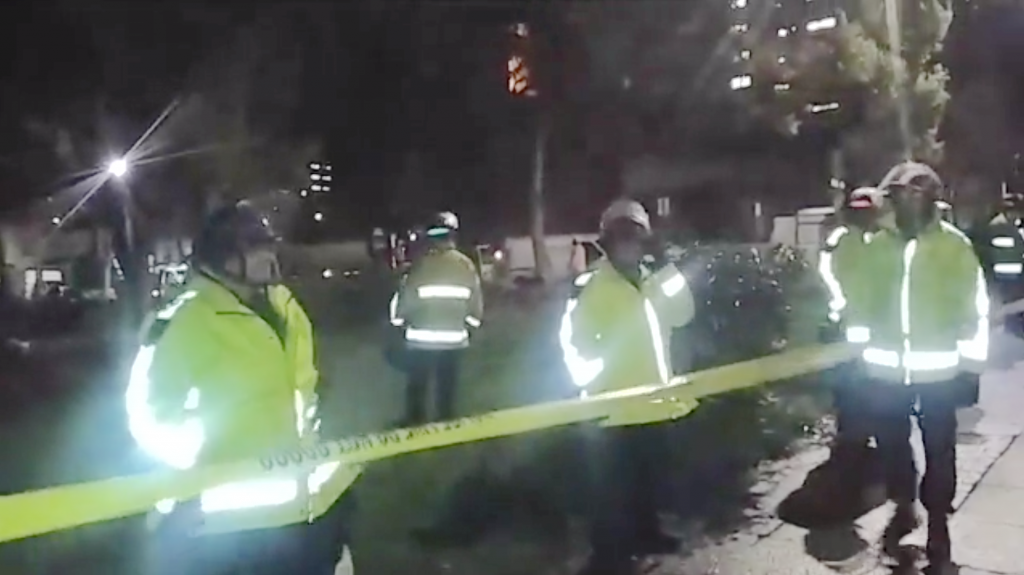
5:08 am
More than 15 cops are at the park in force.
5:12 am
They came about a hundred deep or so
6:04 am
Tree cutters are operating. Chainsaws are going.
6:40 am
It’s a mess out there. The camp is cleared and the trees are coming down. The police are surrounding each tree as they begin to cut. There is one news van. I called Channel 7 and Marie King called Channel 4. The police have strung caution tape around the entire east end of the Park, Bowditch is closed. They would not allow me to walk up Haste.
I saw and spoke briefly with Ruben Lizardo of UC Capital Projects. I said we had questions and would be in touch.
Ninja (David Joshua Teague) live-streamed on Facebook. (1 hour, 28 minutes)
Adam Ziegler, Michelle Lot, and James Cartmill have been arrested. The tree-sitter was removed, but not charged or arrested.
7:35 am
Two paddy wagons in the parking lot across from the People’s Park.
8:58 am
I was in a vehicle parked on Haste near Bowditch early this morn and witnessed the entire operation as it arrived and rolled out, from that vantage. Seems Command was right outside. We were surrounded by tactical personnel, a variety of vehicles, but couldn’t see all the way over to the protest camp very well.
I’d had strong intuition of this coming down since Sunday, although not at quite this scale. Just as I was wondering how wrong I was, only a few hours ago…
Sunday, after the meeting, I was concerned that there was NO signage identifying and positioning the action to the public, which I’ve regarded as of the utmost importance. I offered to produce some pieces, and to contribute ALL the necessary materials and supplies… if someone could provide transport to my storage and back.
As it is now, the media has plenty of shots and footage of shabby camp remains and wild-eyed, wet wingnuts ranting obscenities and incoherent accusations or threats – which I’m sure will become the promoted face and message of it all.
I hope folks have learned an important lesson from this progression, albeit an expensive one.
9:03 am
I saw several marching phalanx formations arrive. My initial impression was maybe 200 or so. The persons in yellow raincoats are not UCPD. Campus “escorts”? ROTC?
9:18 am
It’s the Highway Patrol.
9:26 am
BPD had some late night rendezvous with UCPD the past two nights, but no visible particiation this morn. Just State Cops, huh? A few nights ago, I’d spotted several “men in black” in the background taking pics/vids when UCPD confronted camp, then they faded back to surveillance positions on properties across streets.
9:33 am
Please guys keep safe,thank you for being there
10:09 am
So, this is interesting — UC posted this very informative press release about 17 hours ago to cover their asses.
https://news.berkeley.edu/2019/01/15/peoples-park/
This timeline of events was gather from the People’s Park Committee mailing list. Contributions by Lisa, Christopher, Andrea, David, Eleanor.
Photos after the second tree killing
These photos are from around 3:45 PM January 15, 2019 a few hours after the tree killing and arrests of protestors who were defending the remaining trees of the East-side forest of Peoples Park. At least seven trees in this community of conscious living tree beings were cut down including two beautiful young olive trees who were always visited by this writer, and others had massive limbs removed. All of these trees had many friends and visitors. This gut wrenching loss adds to the loss on December 28 of about 28 trees. The community of local individuals of various species are shocked and devastated by this terrible attack and destruction of habitat.
Photos with commentary by Greg.
Last updated 11:55 pm
Innovative Student Housing Architecture Can Help Protect People’s Park
by Greg Jalbert
The People’s Park community has innovative solutions to UC Berkeley’s student housing needs, as illustrated here with architectural sketches from Alfred Twu, UC Berkeley alumni.
The Durant Avenue space may get this innovative remake into new wonderfully located student housing near campus and an excellent selection of restaurants and other businesses. Let’s make Berkeley a more inviting city, protect and expand inviting green public spaces, walkable city spaces.
The Durant Avenue project remake three lanes of underused asphalt space into student housing and outdoor green park space, including some isolation barriers from traffic visual and noise pollution, outdoor dining spaces for customers of the local restaurants, cultural events and recreation. The ubiquitous waste of space by automobiles in urban architecture must be dismantled and repurposed for people, the sooner the better. Society and public space would be much better without dreary, polluted, automobile-catering dystopia.
Alfred Twu is a Berkeley designer, UC Berkeley alum, environmental advocate, and serves on Berkeley’s Zero Waste Commission. Alfred Twu put together these sketches of the plan (click images to see high resolution version).
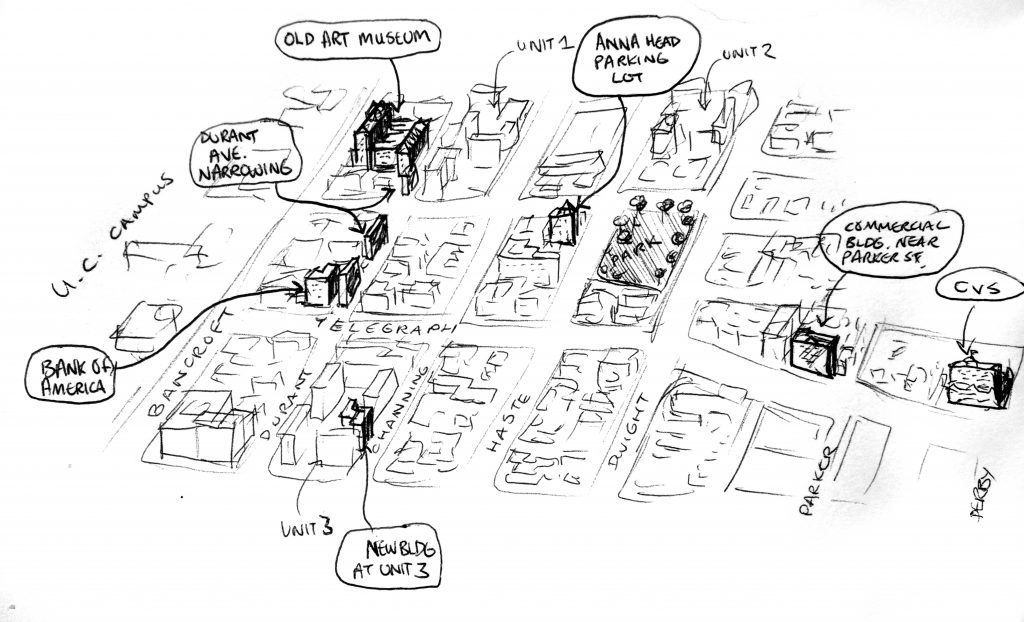
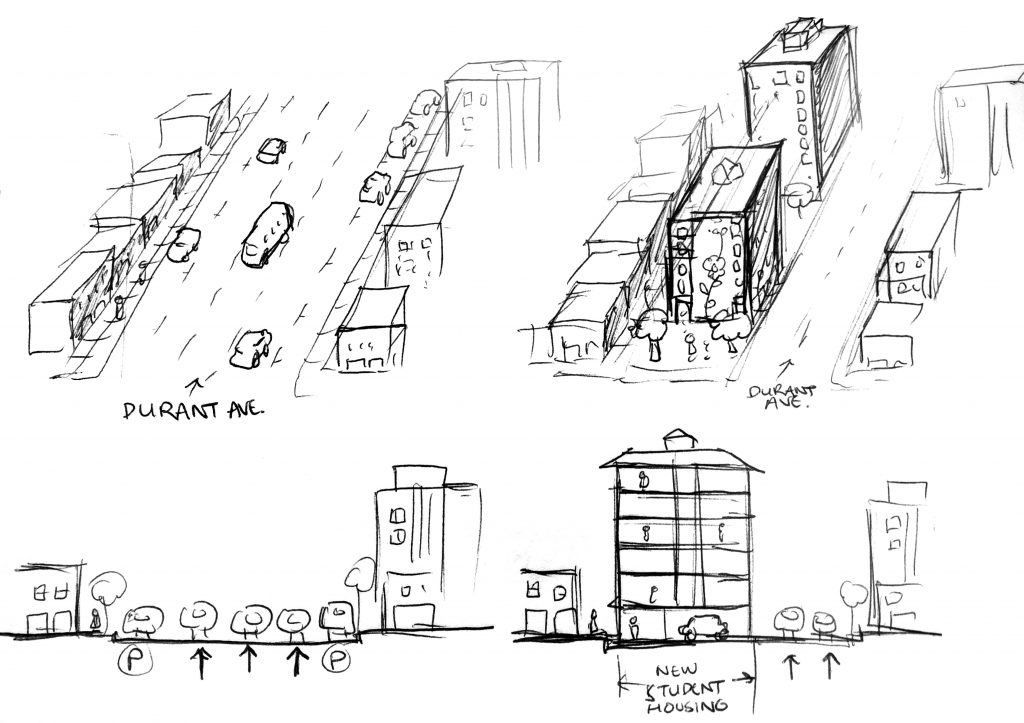
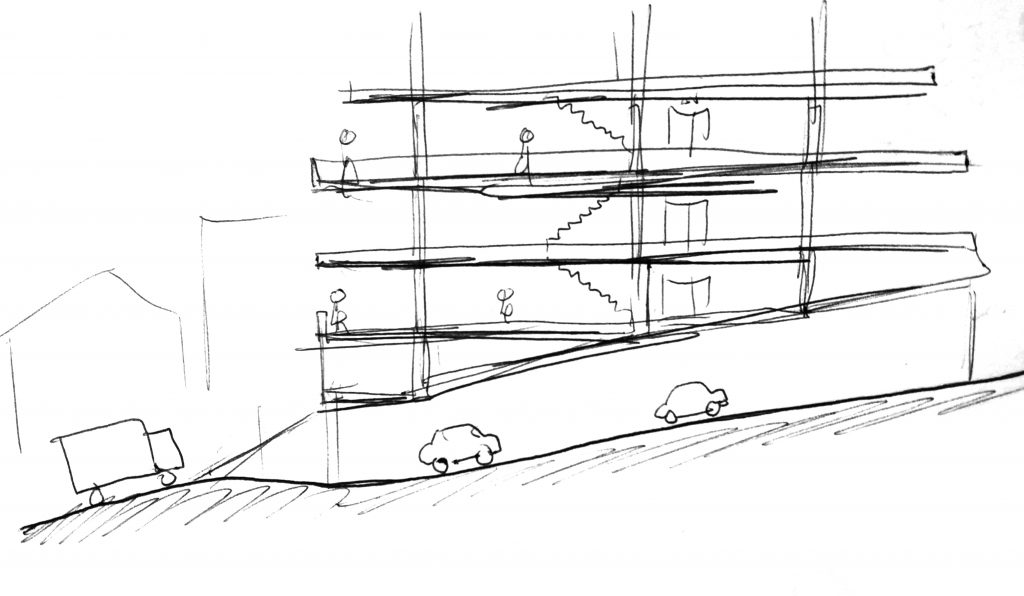
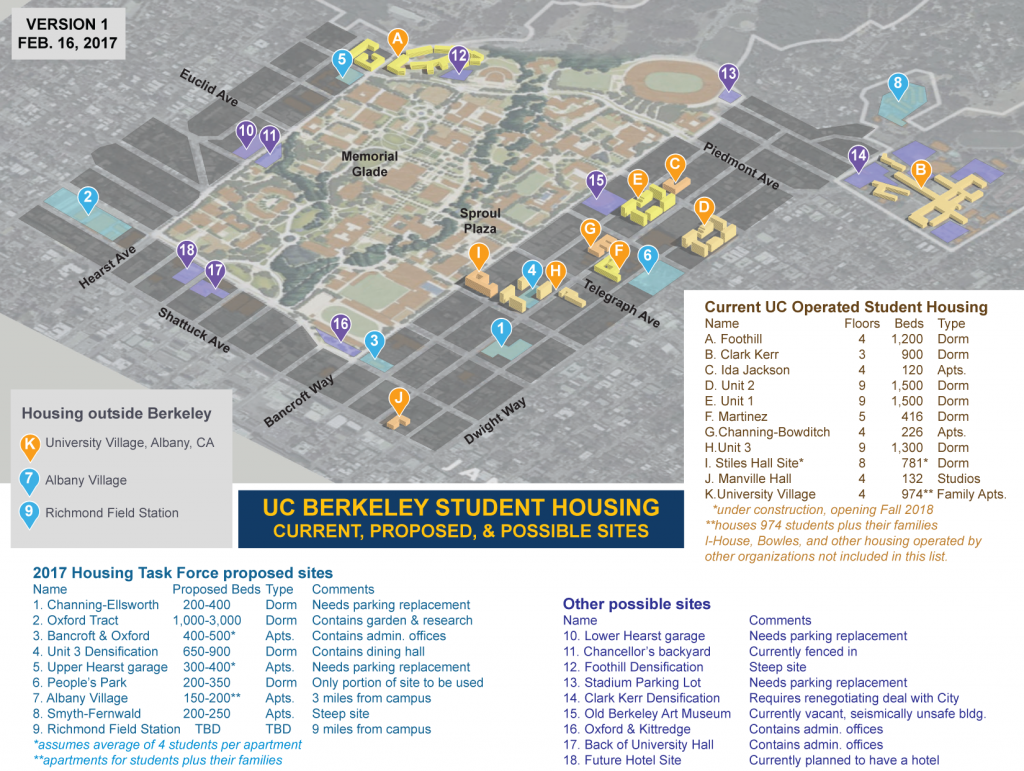
The People’s Park community opposes the UC Berkeley plan to build housing on People’s Park. Their plan removes vital, precious green space from the community. Their plan removes a community gathering place for park visitors of all kinds, neighbors, students, out of town visitors, local restaurant patrons looking for a picnic place, cultural events.
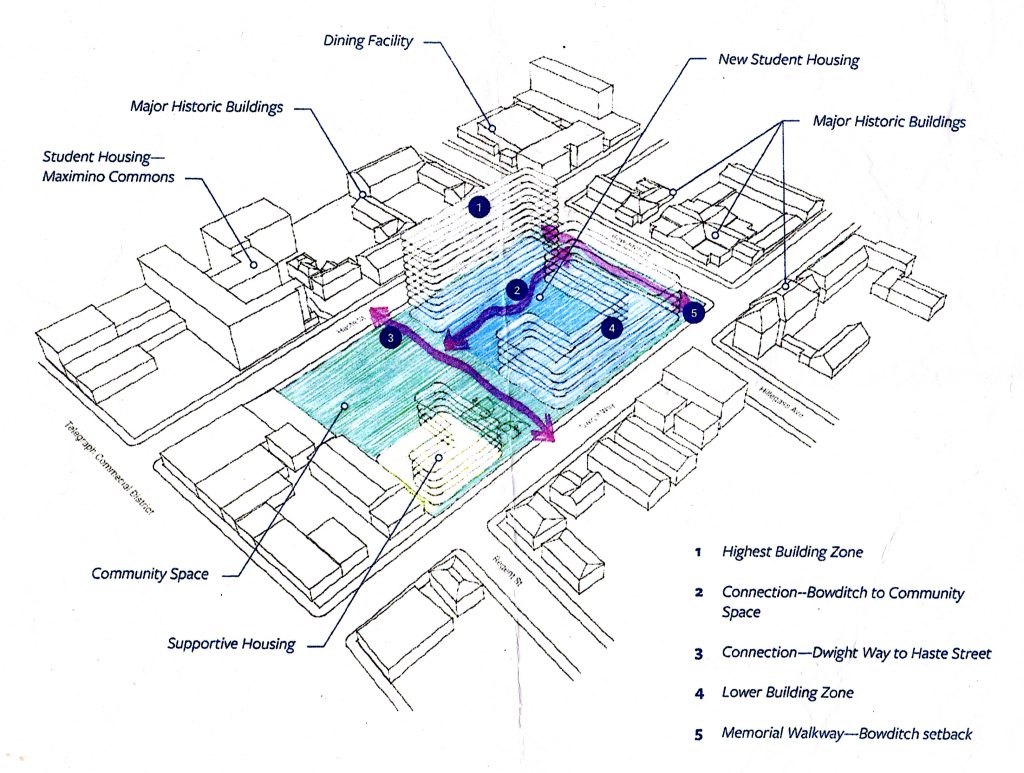
We hope the community engages together to protect People’s Park. Please, get involved. Many resources and links are available on the PeoplesPark.org site.
— Greg Jalbert is a longtime People’s Park community member, having gardened there for several years, played countless hours of acoustic music jams with other community members, and had countless hours of engaging and profound life-enhancing conversations on cultural history, civil rights and social justice, science, gardening, and advocates for the protection of and engagement with this green space.
